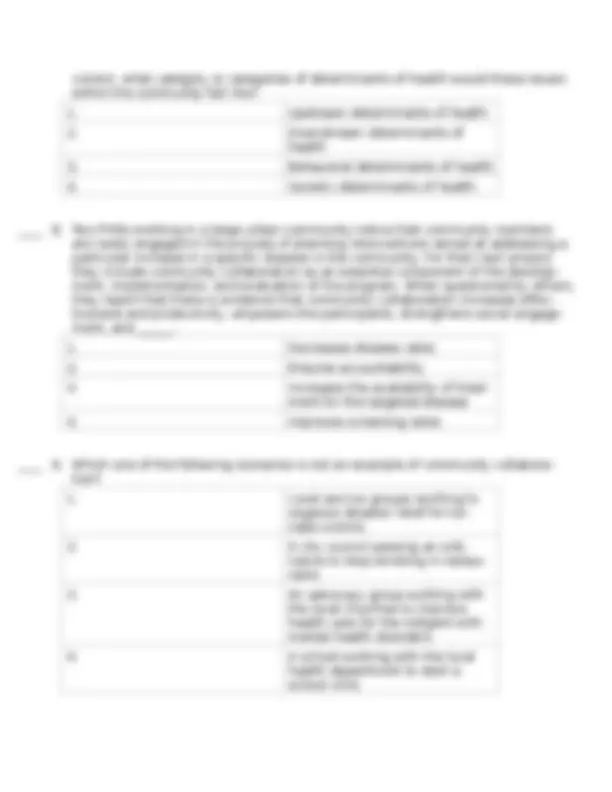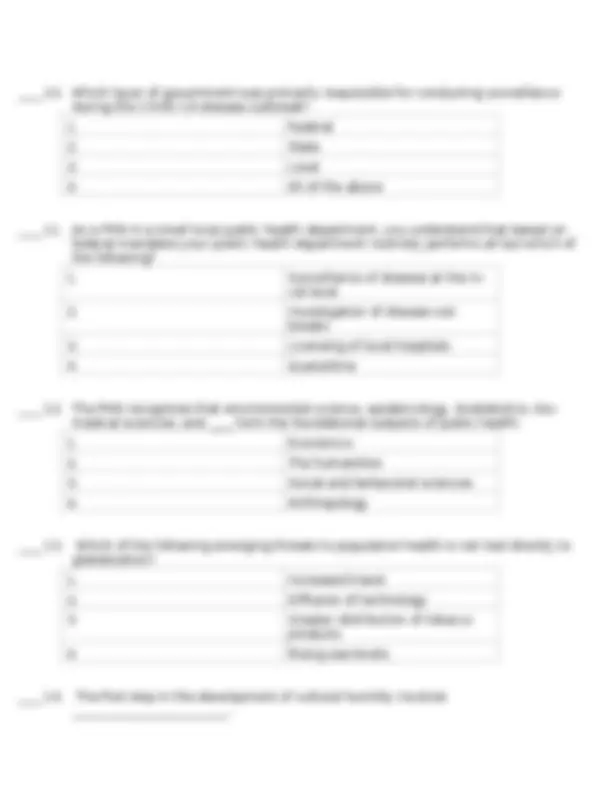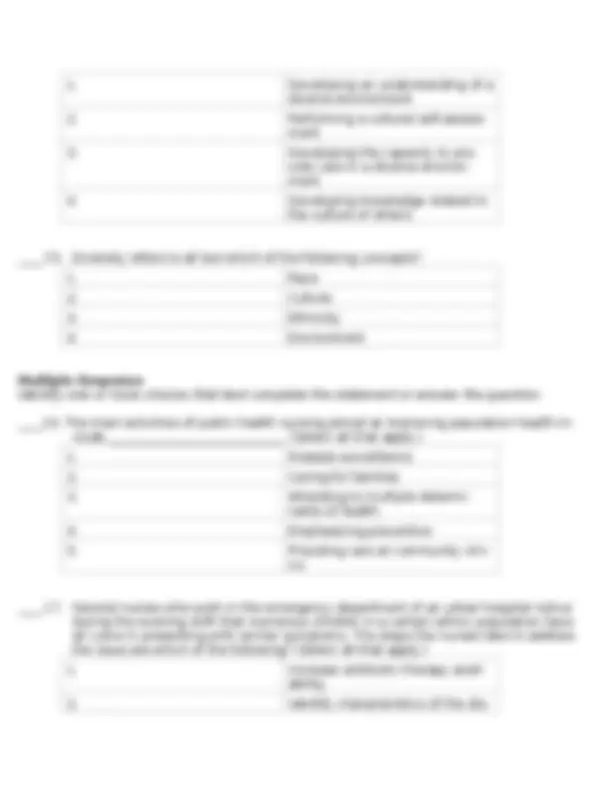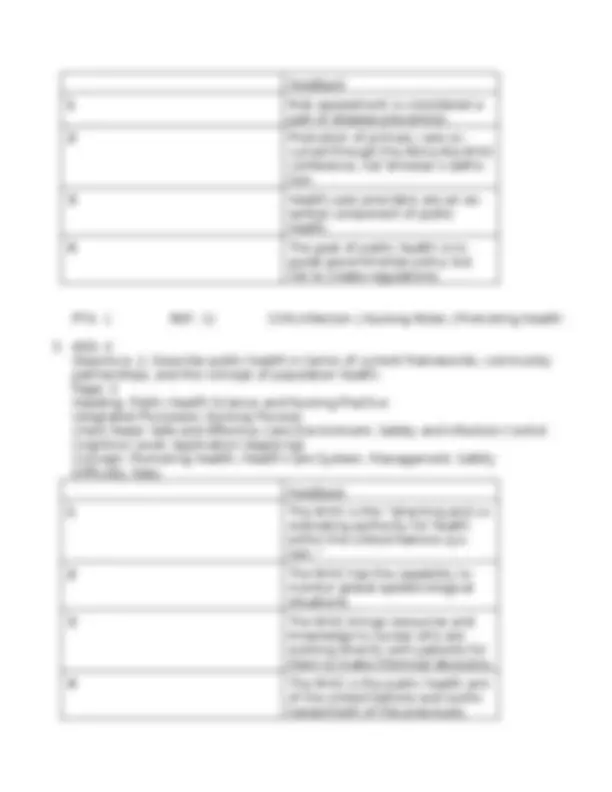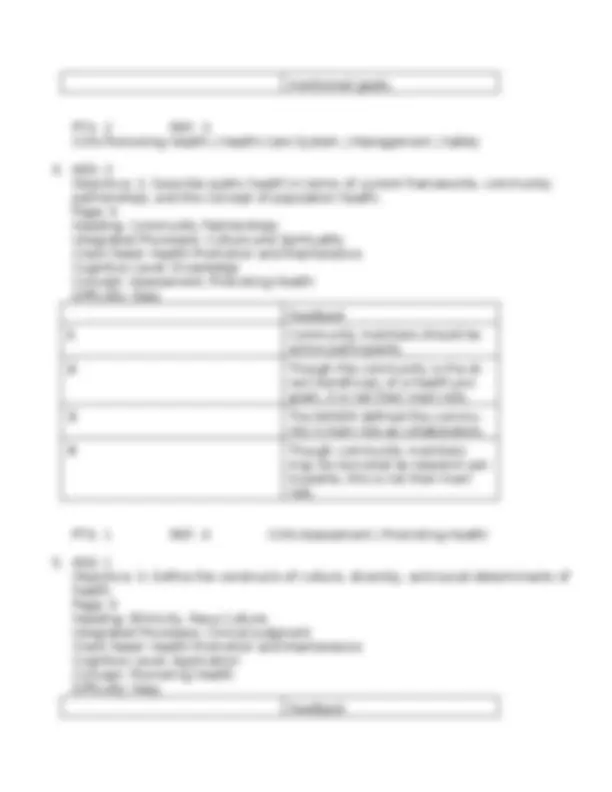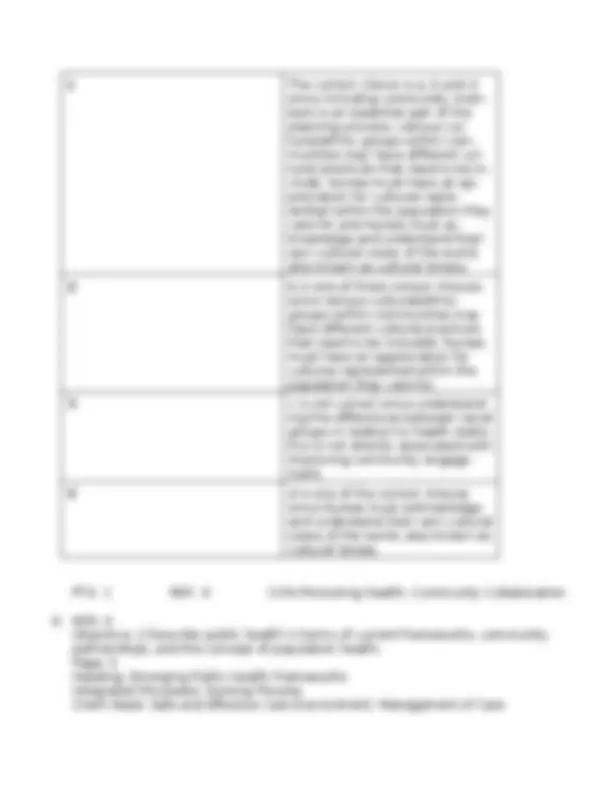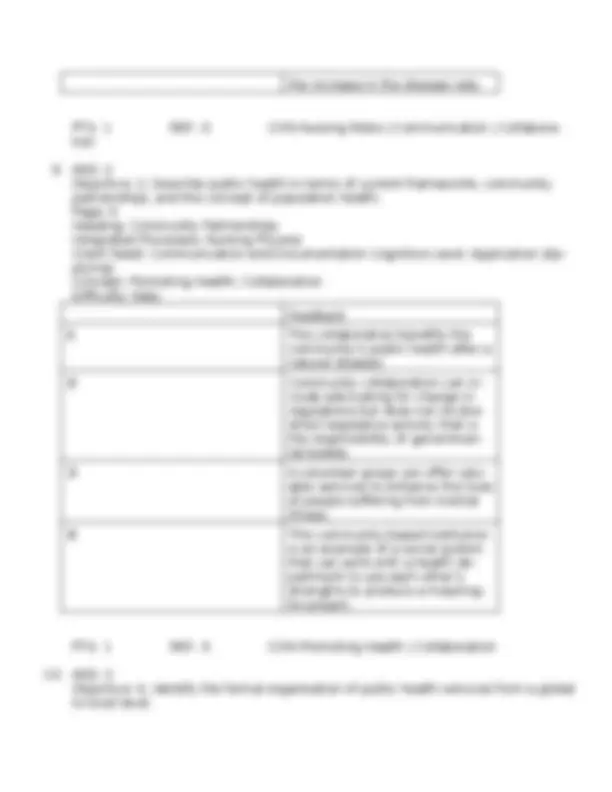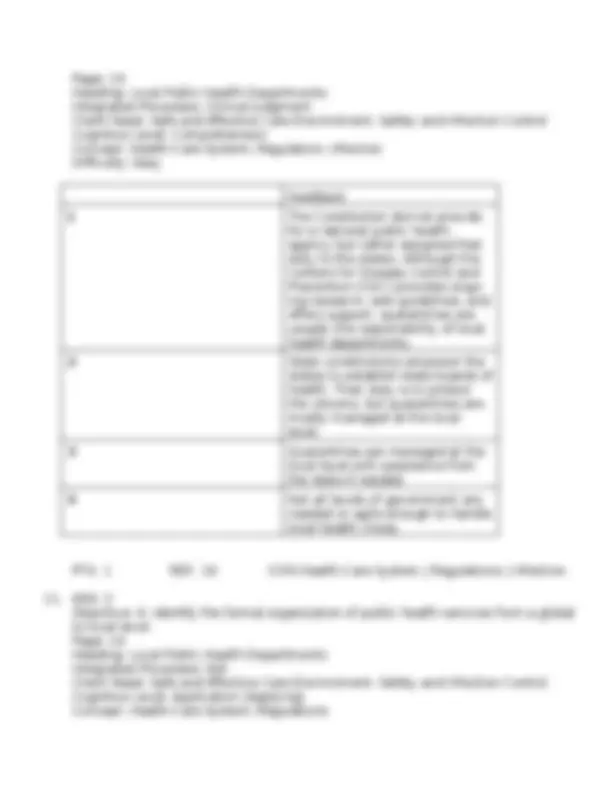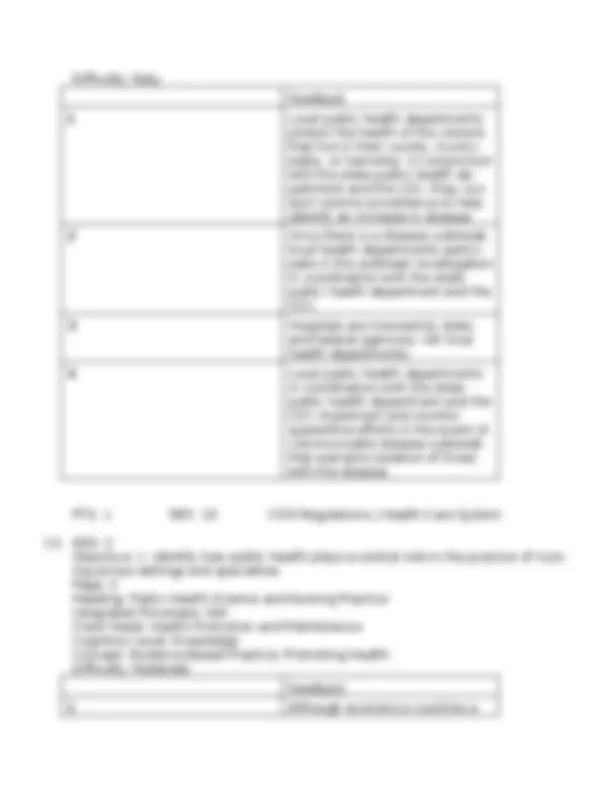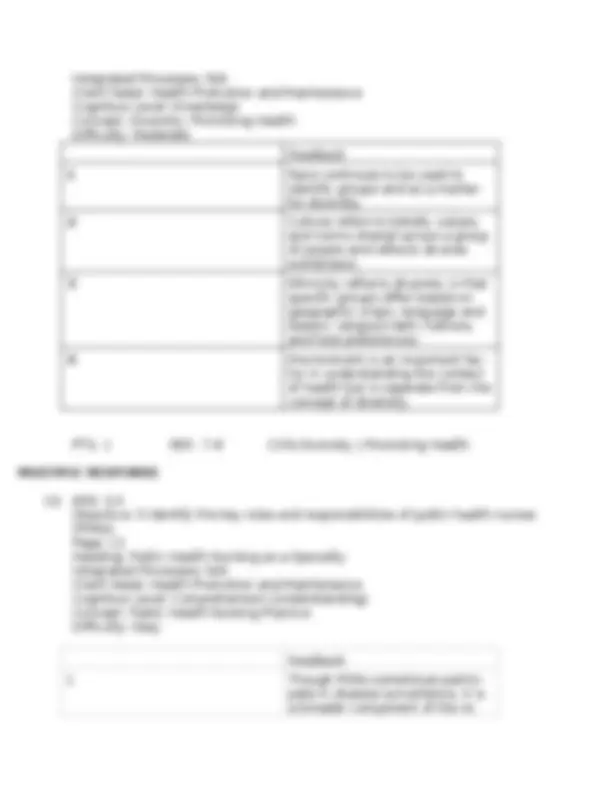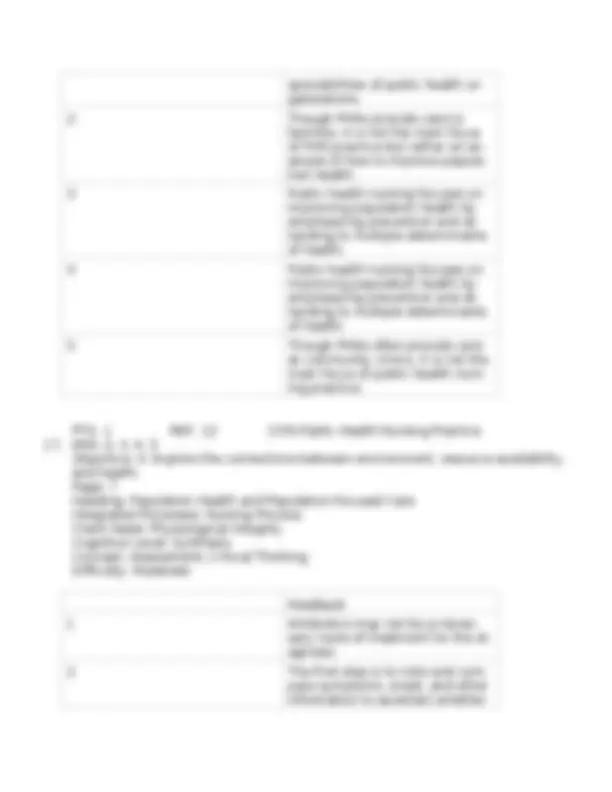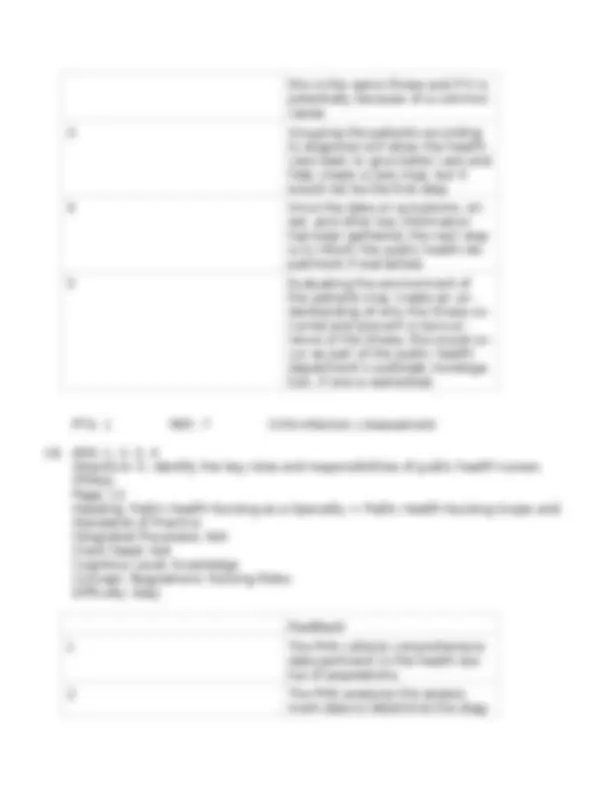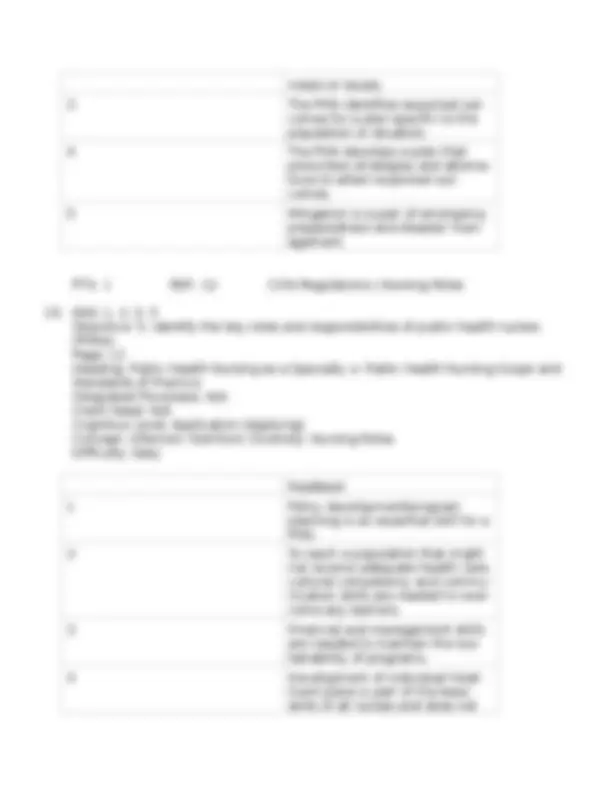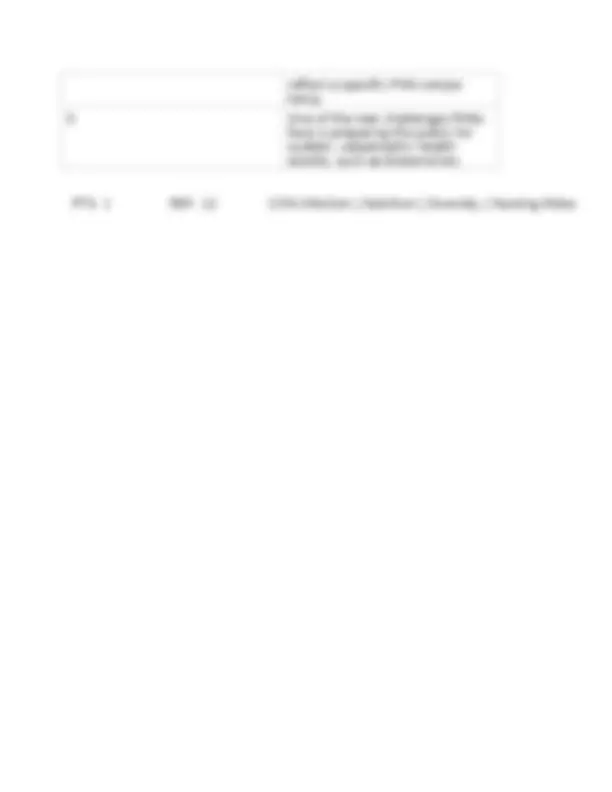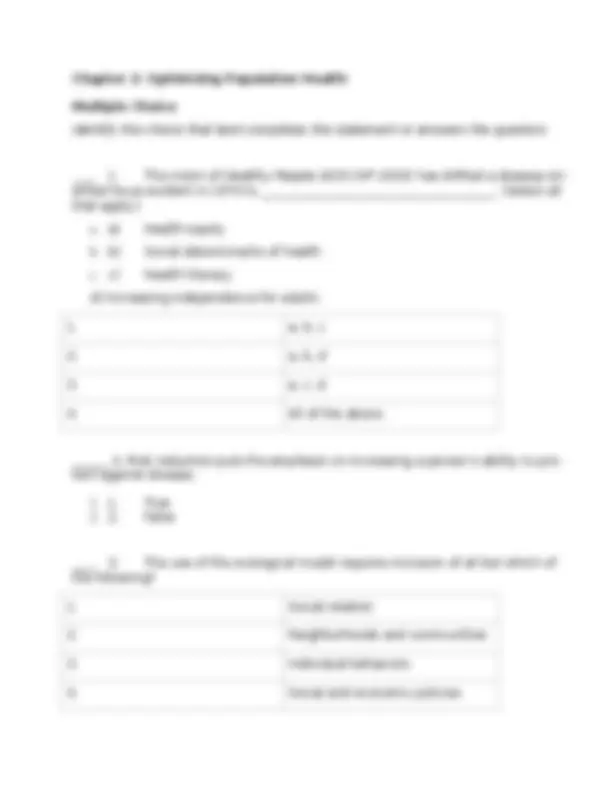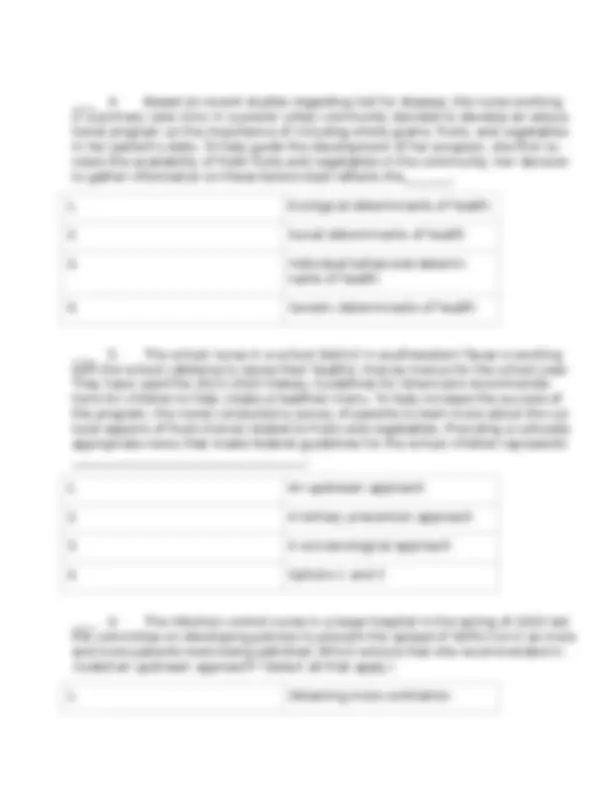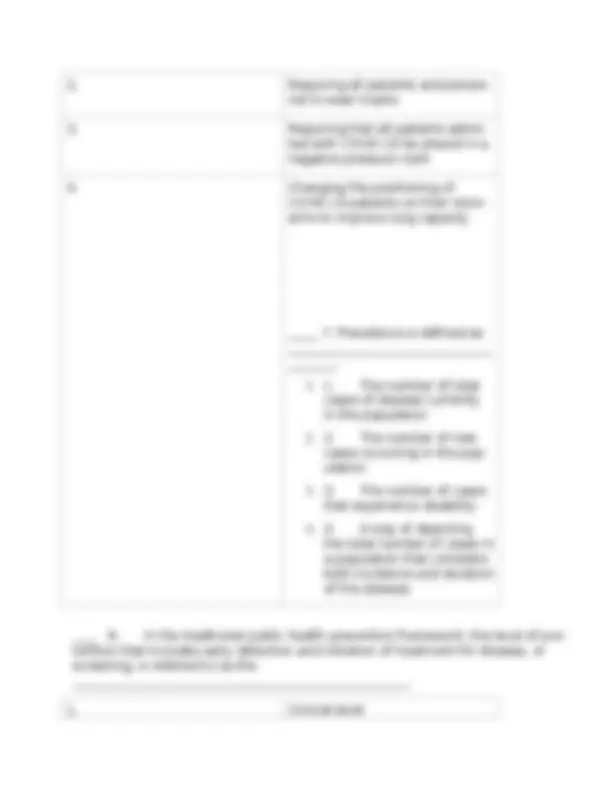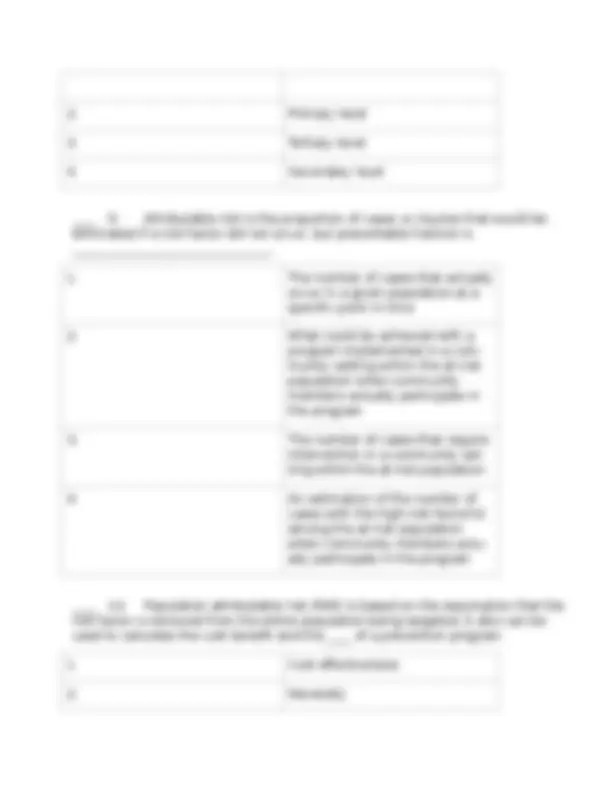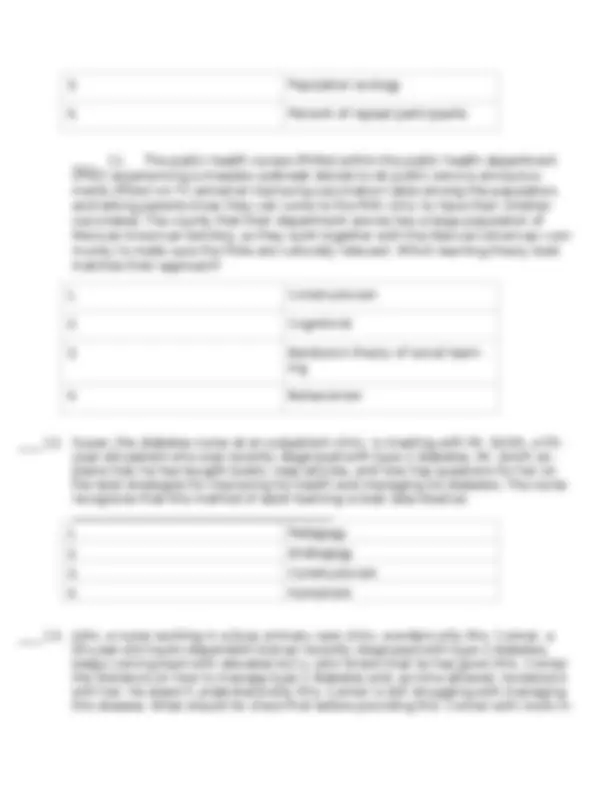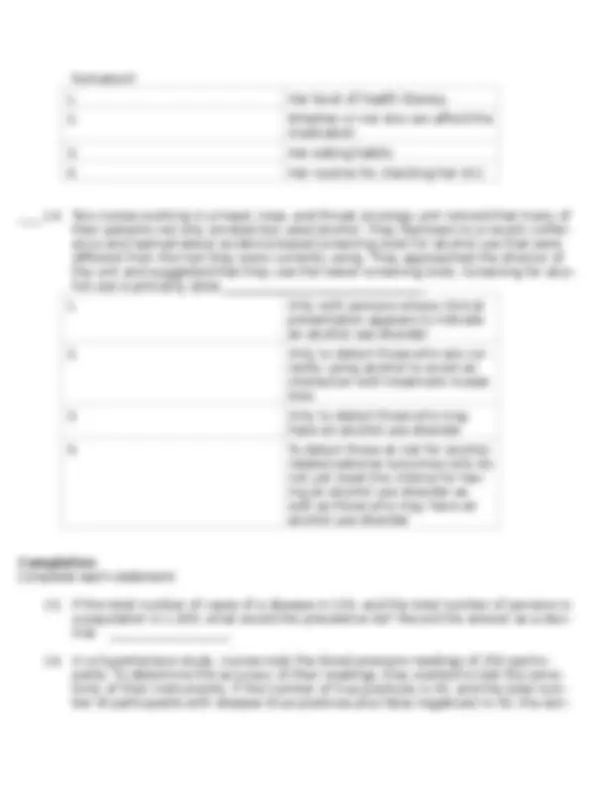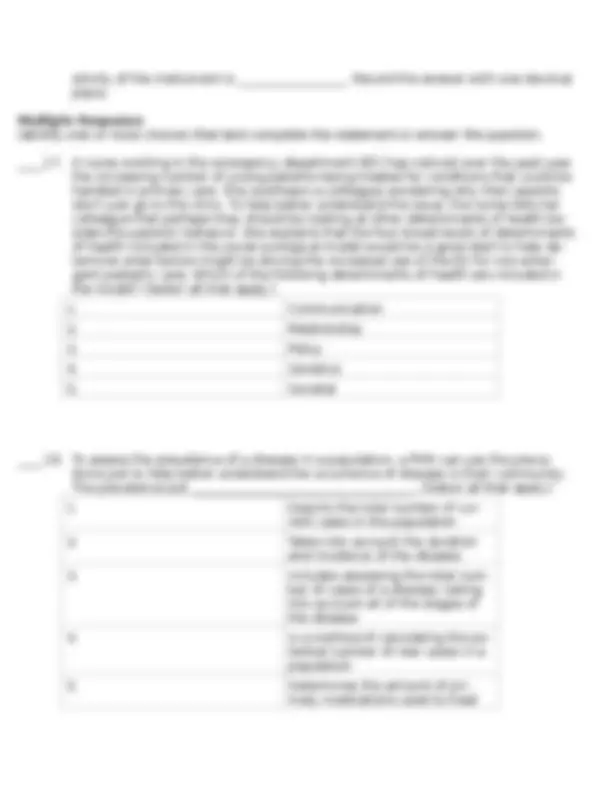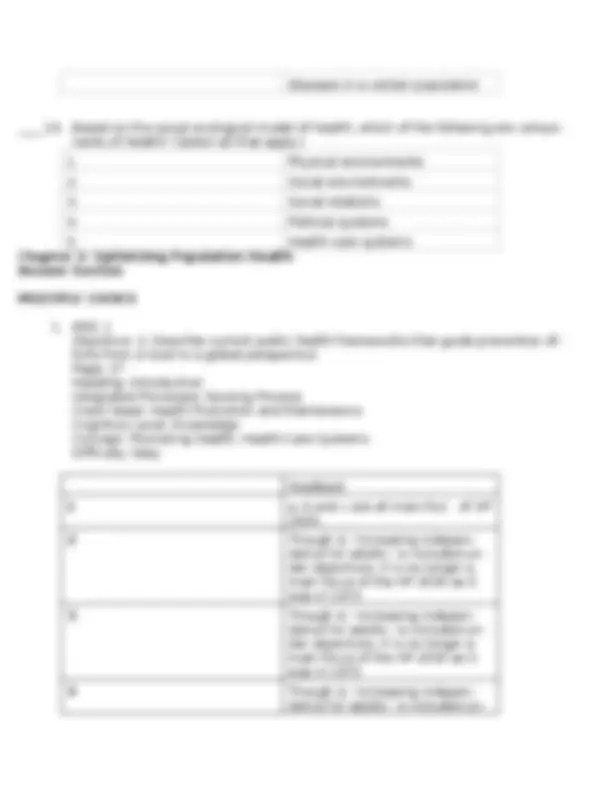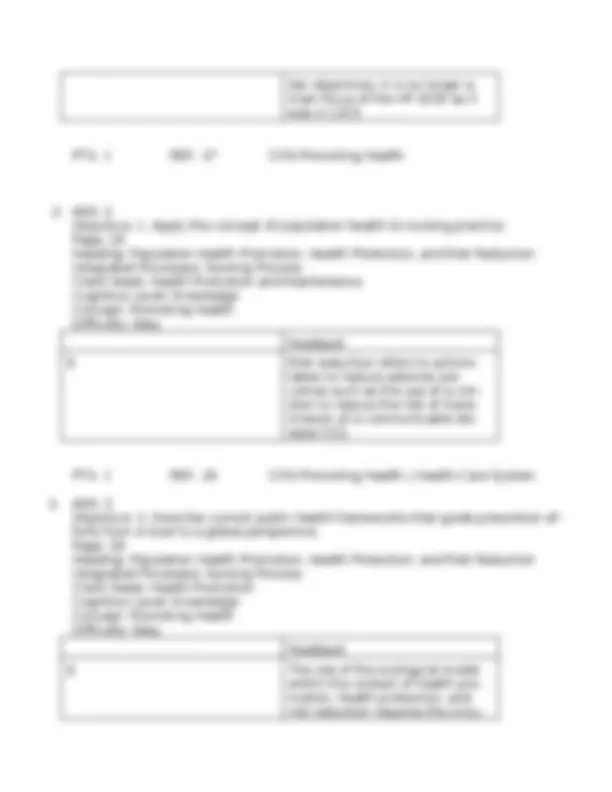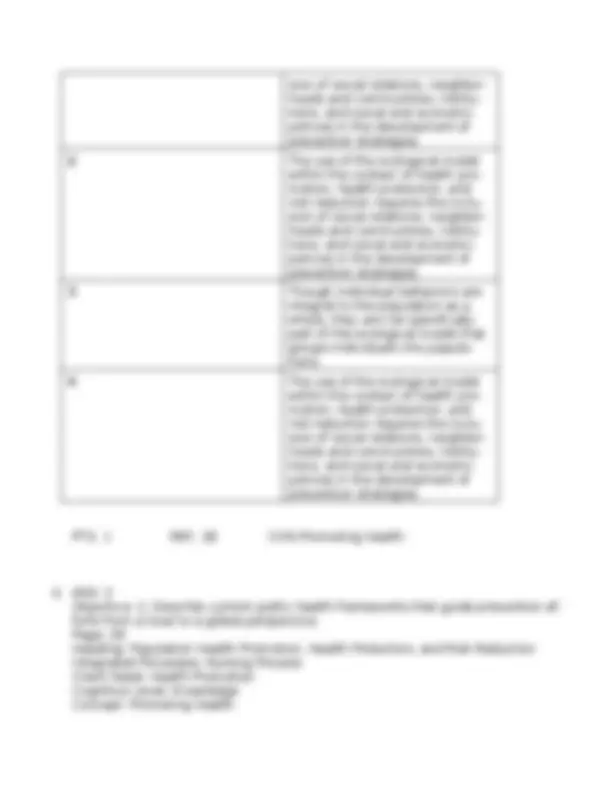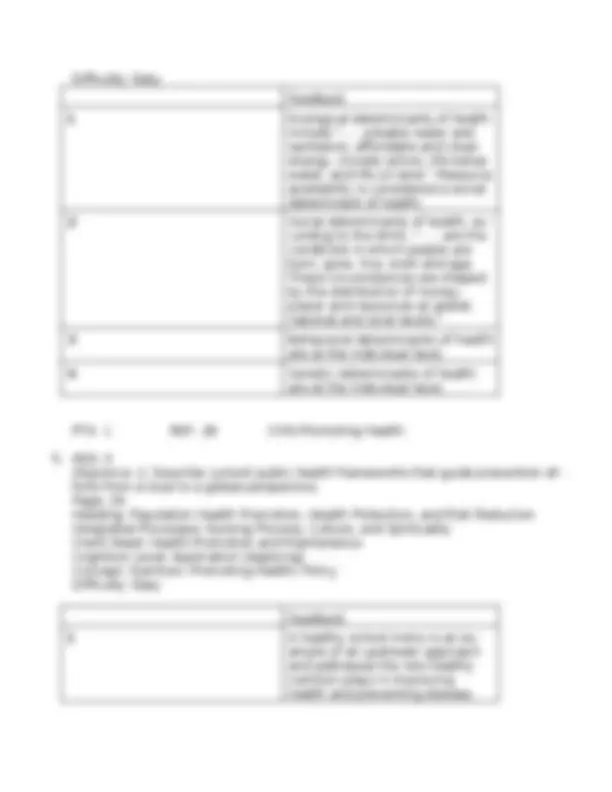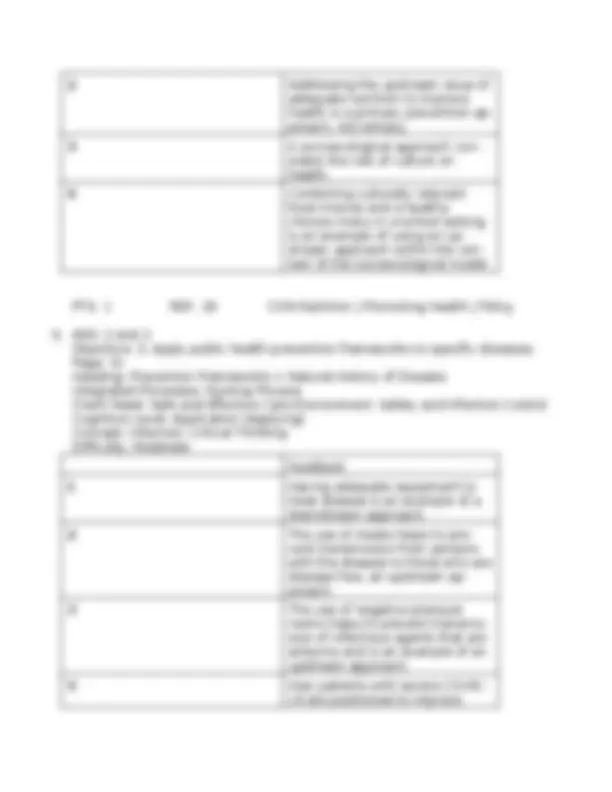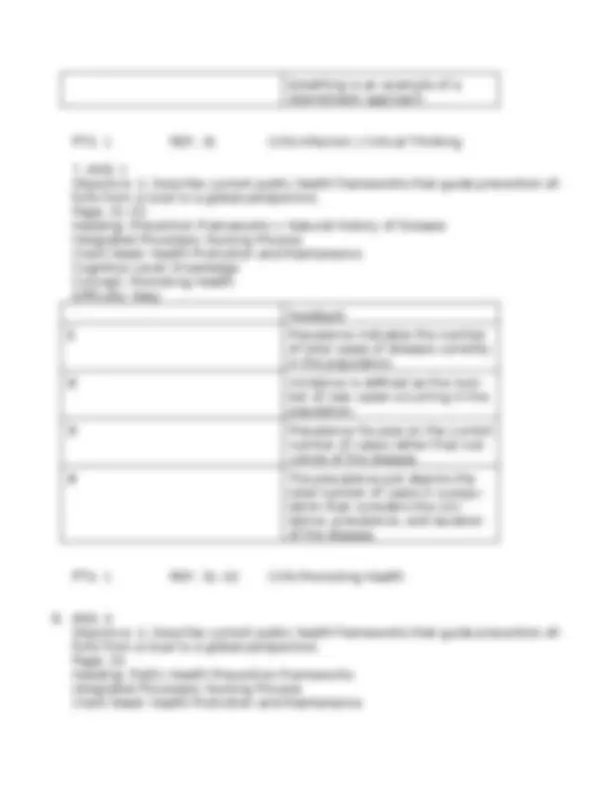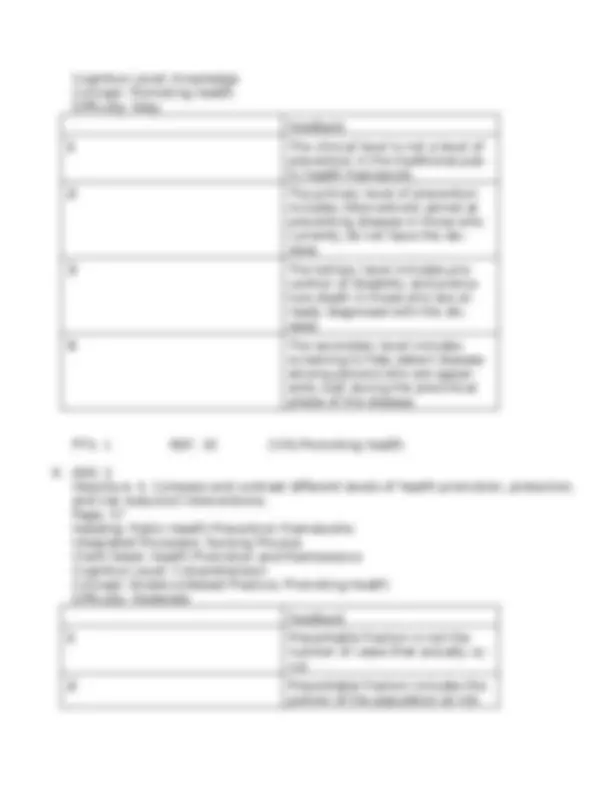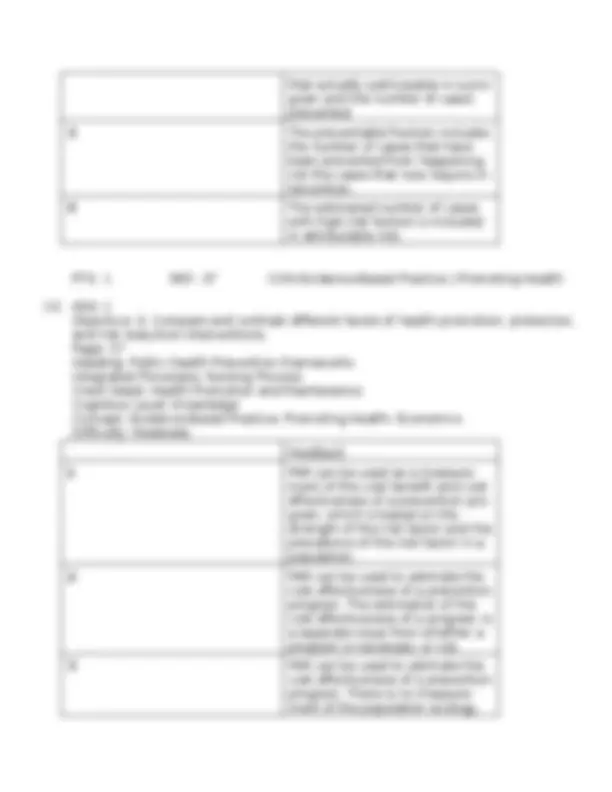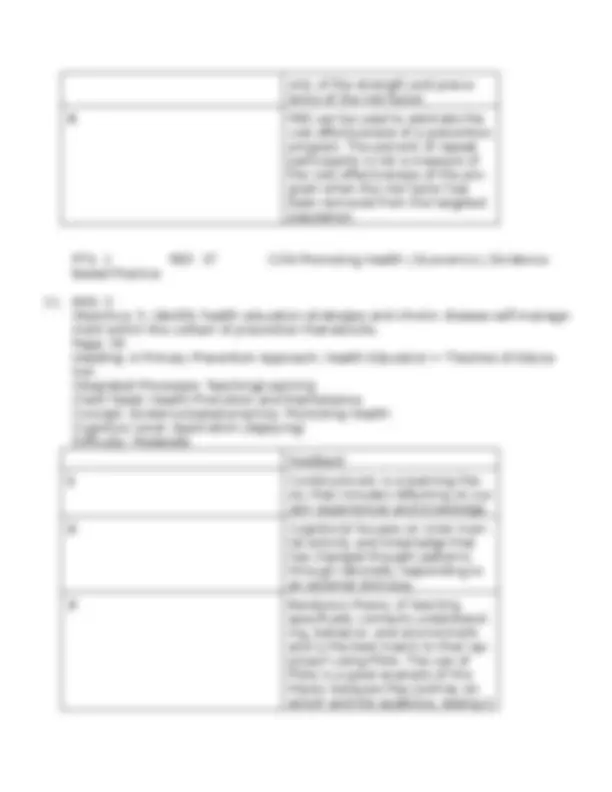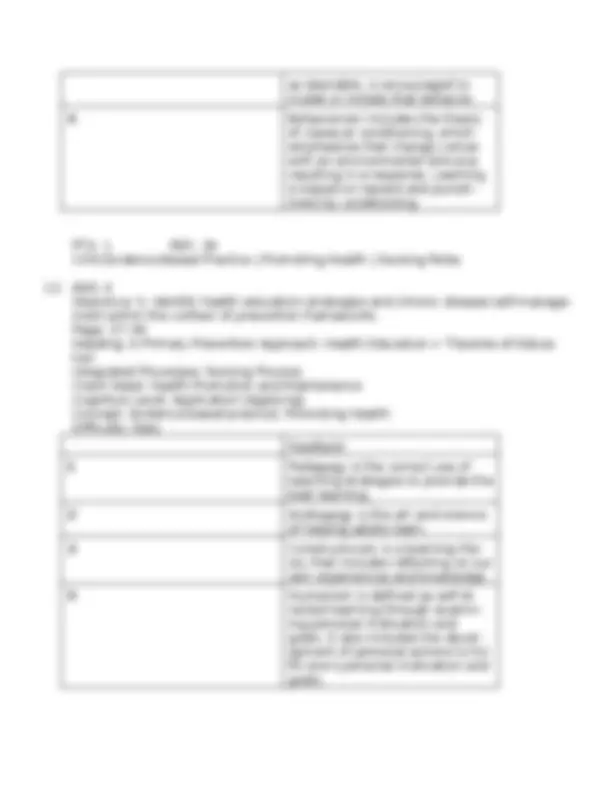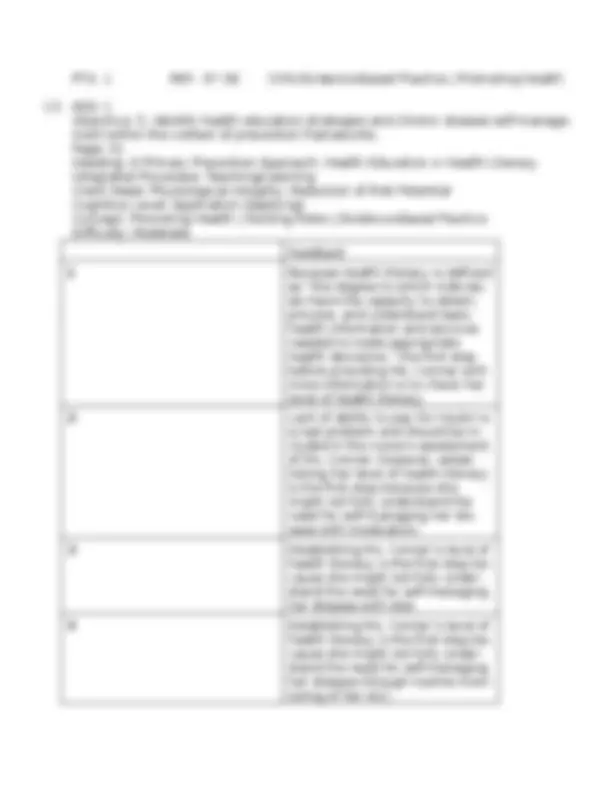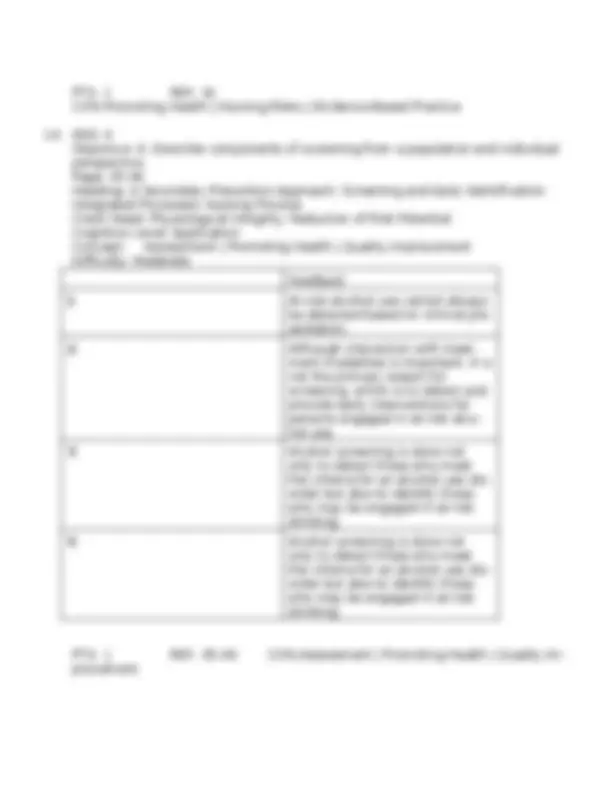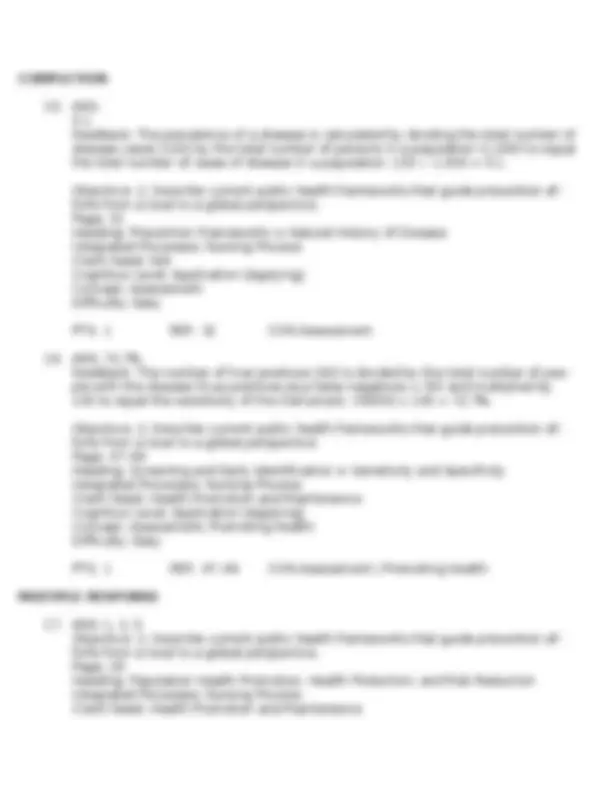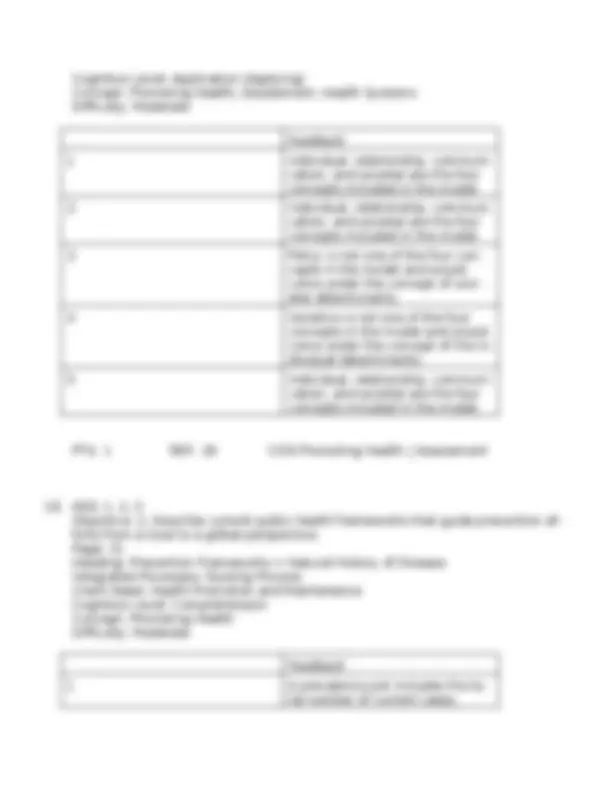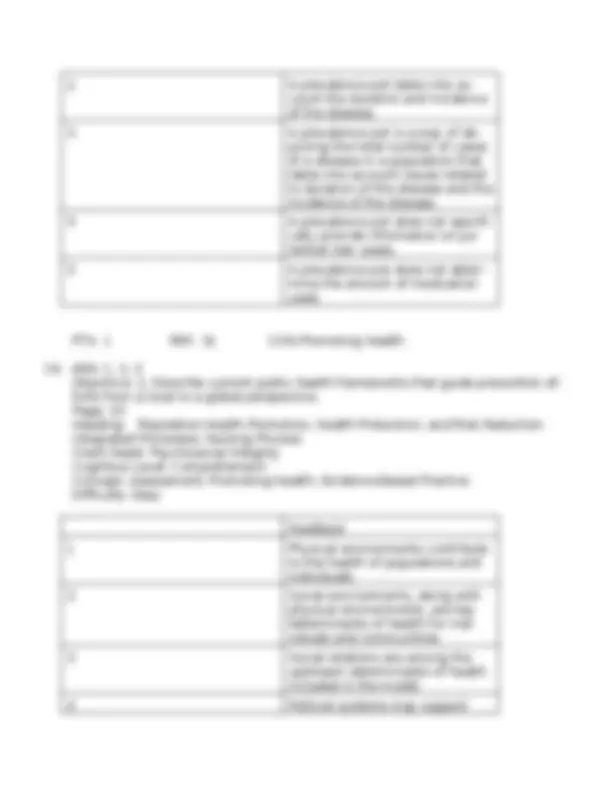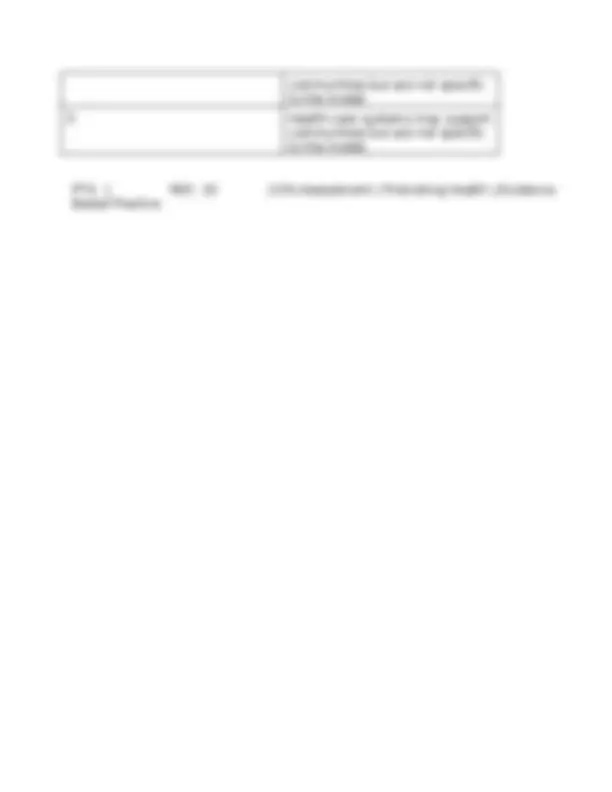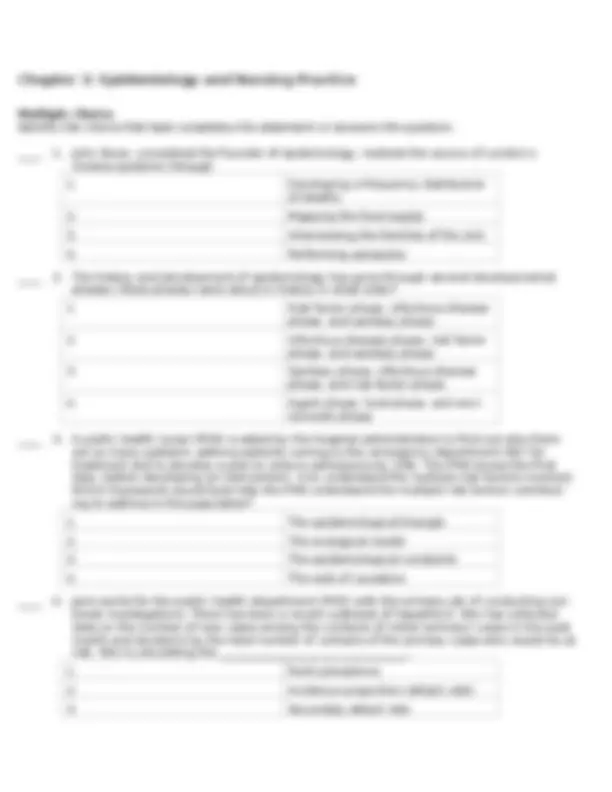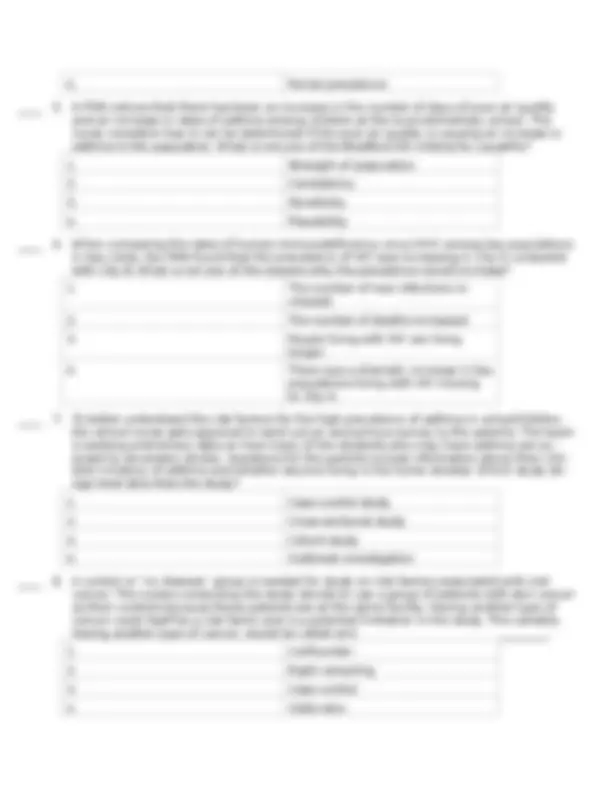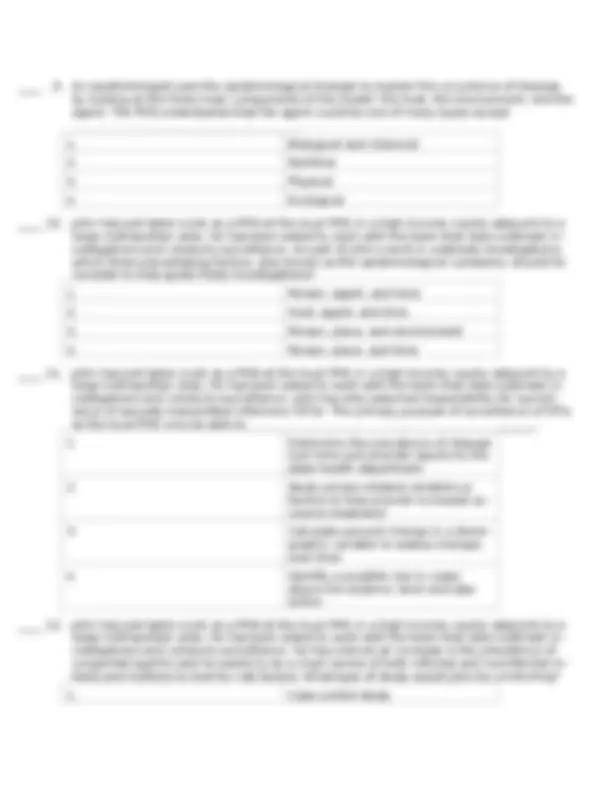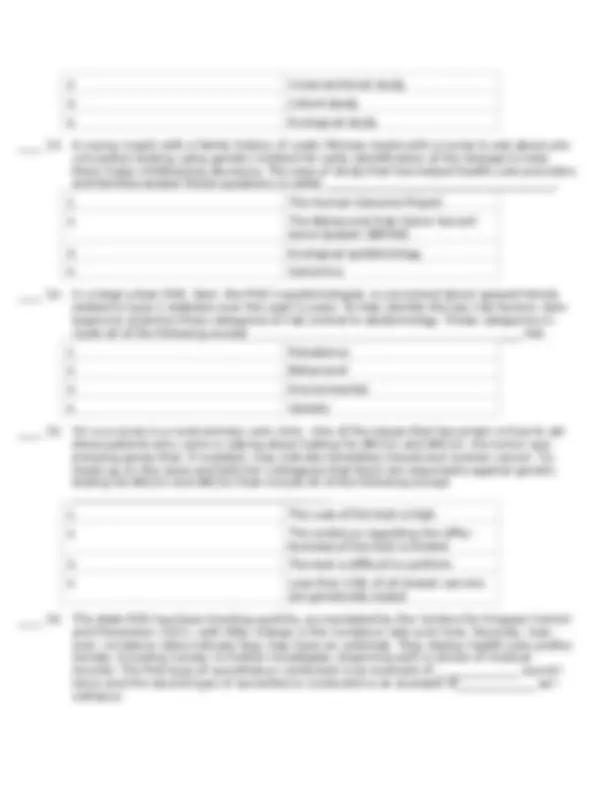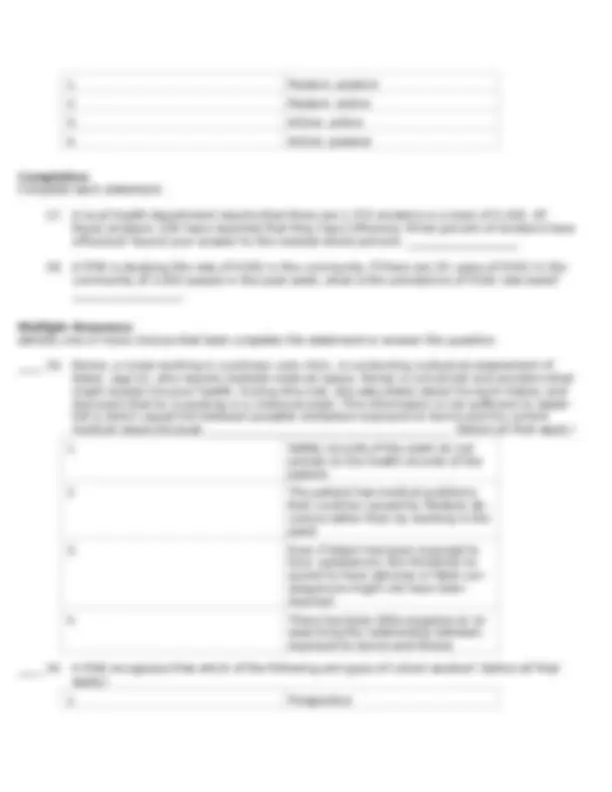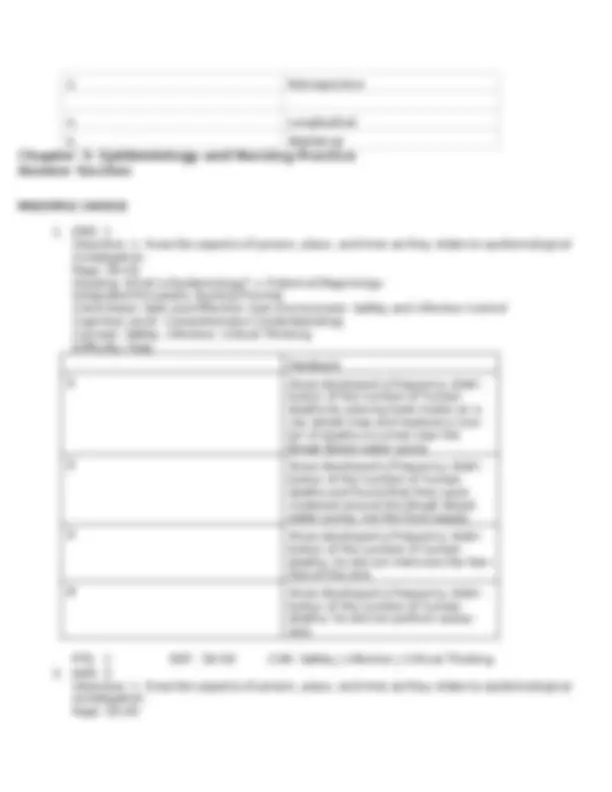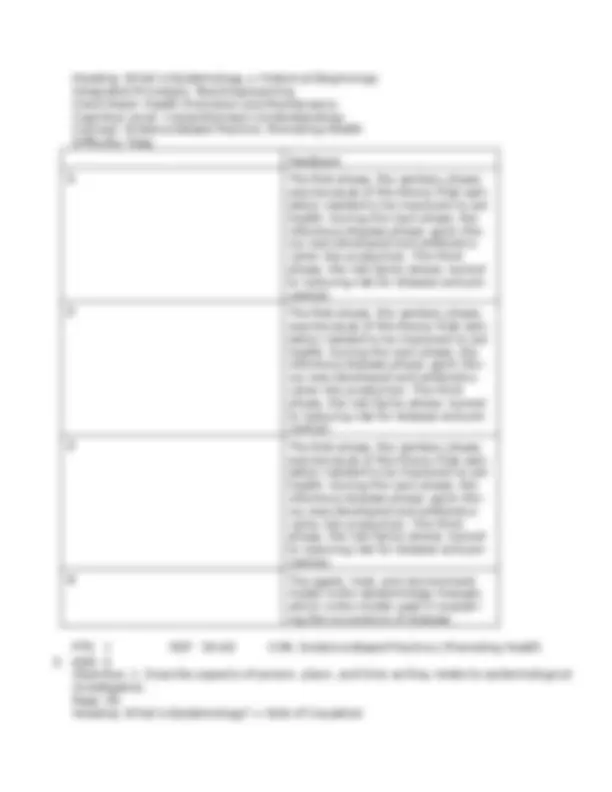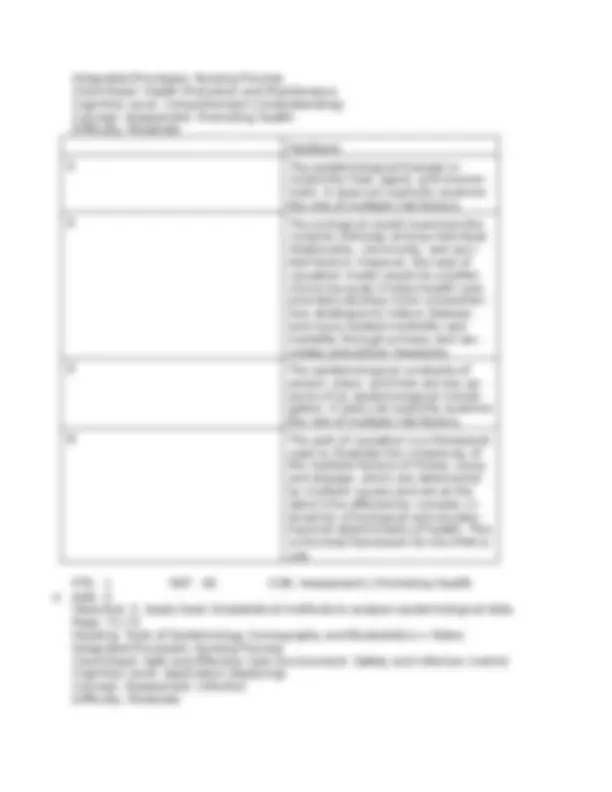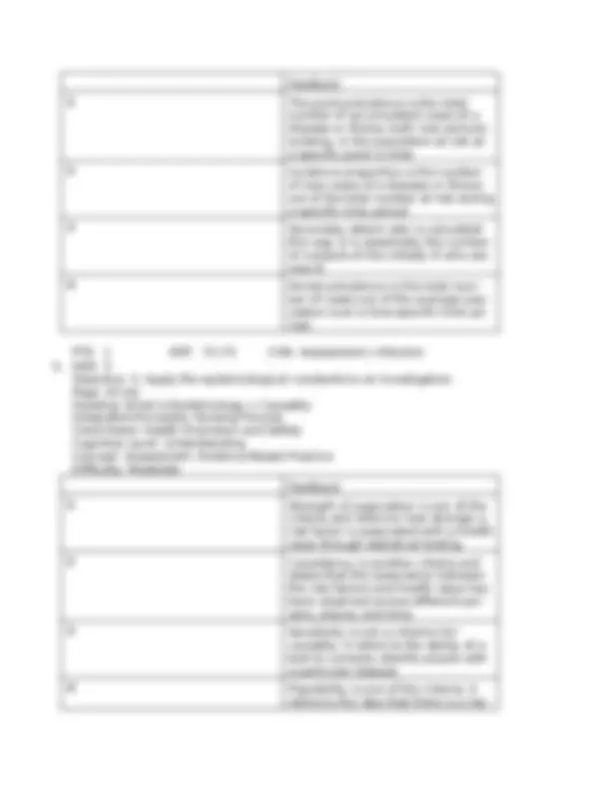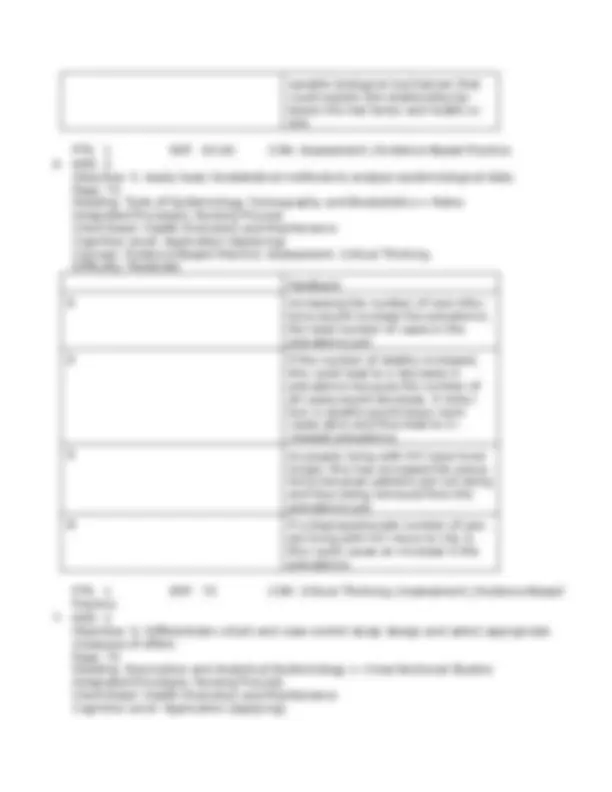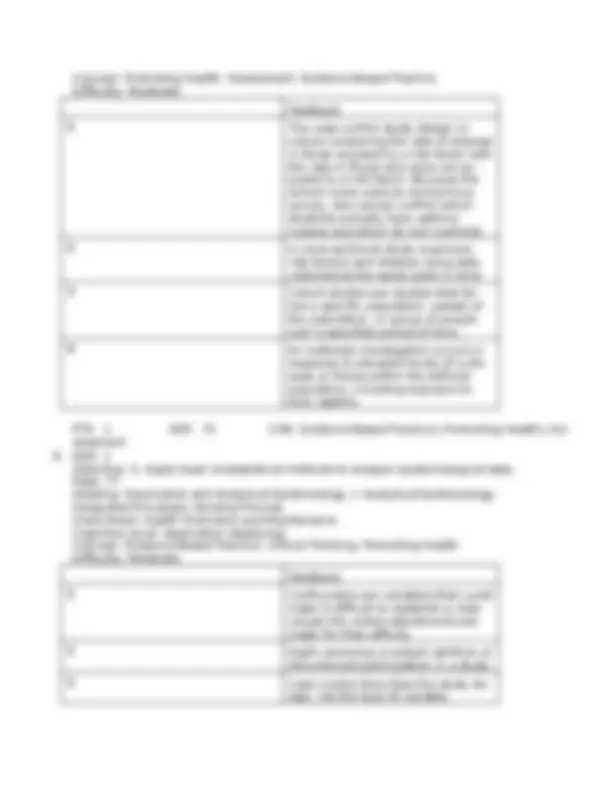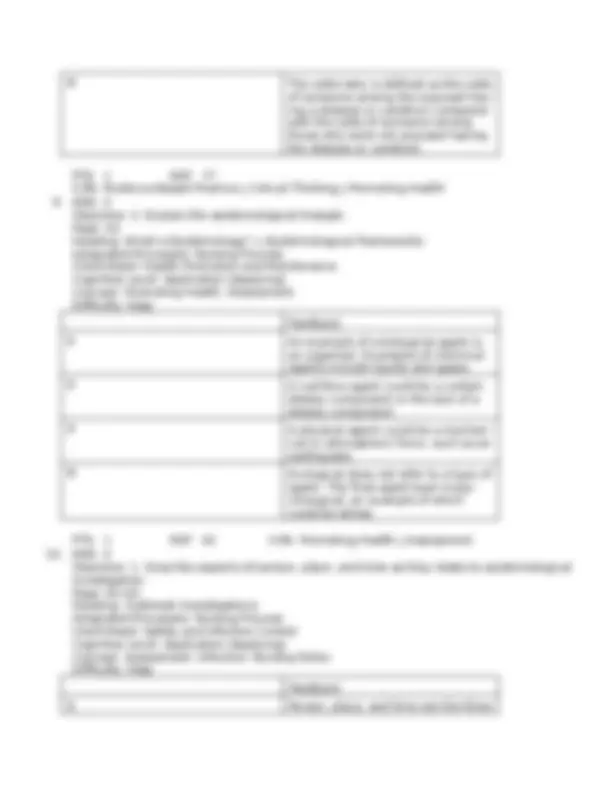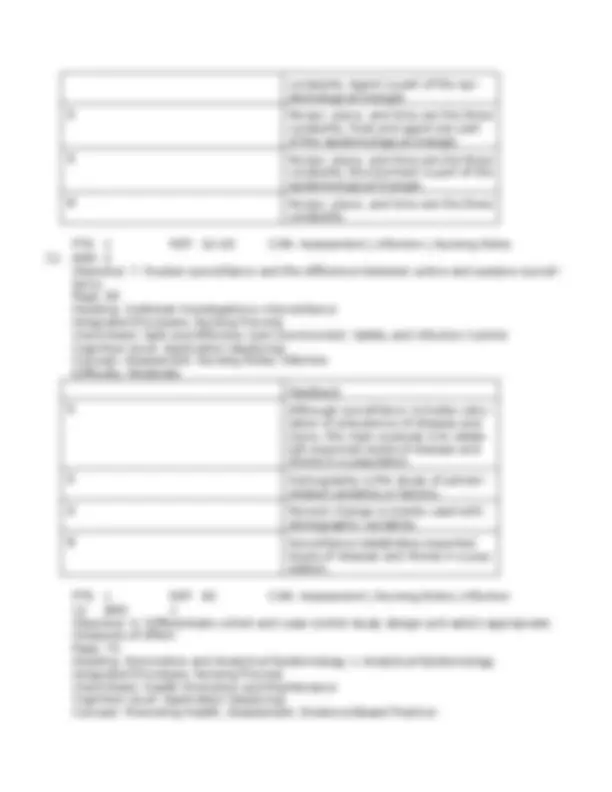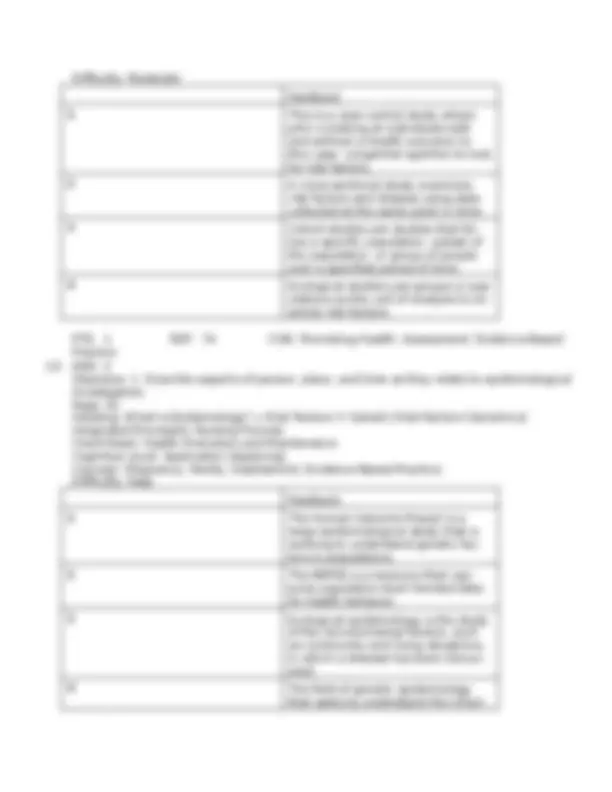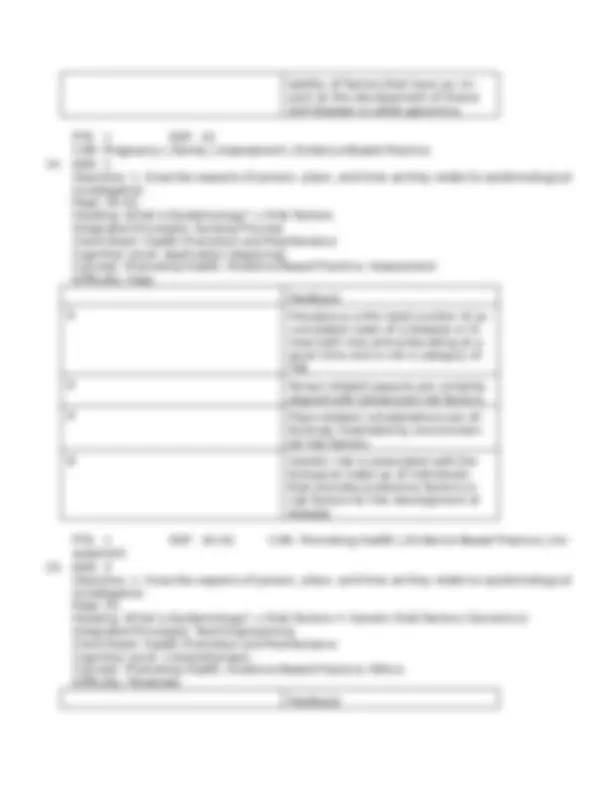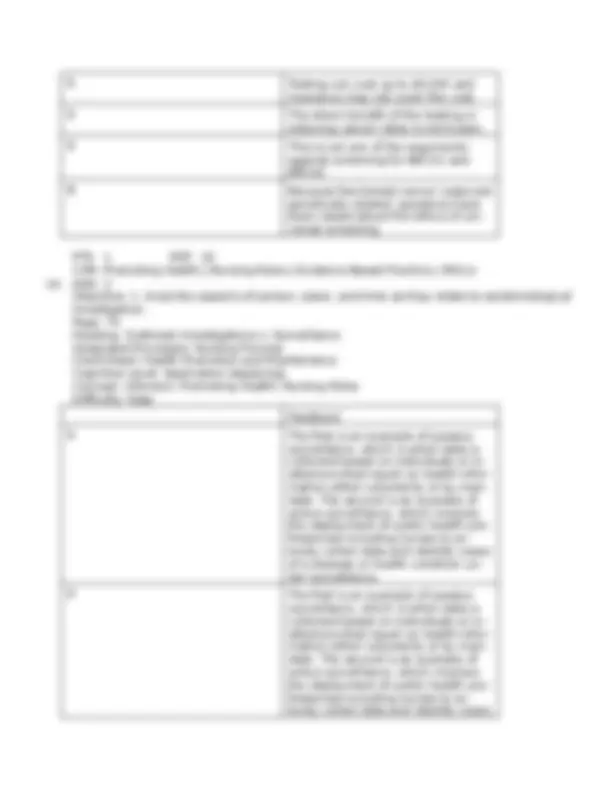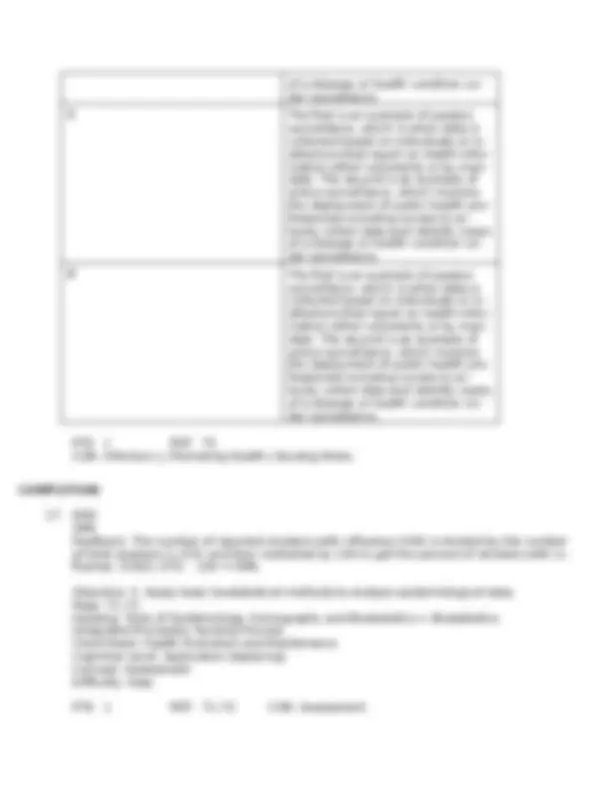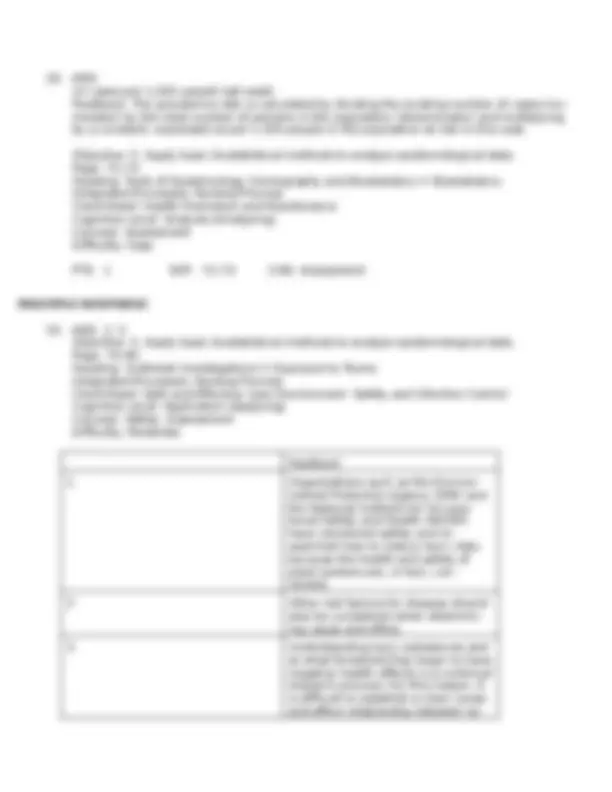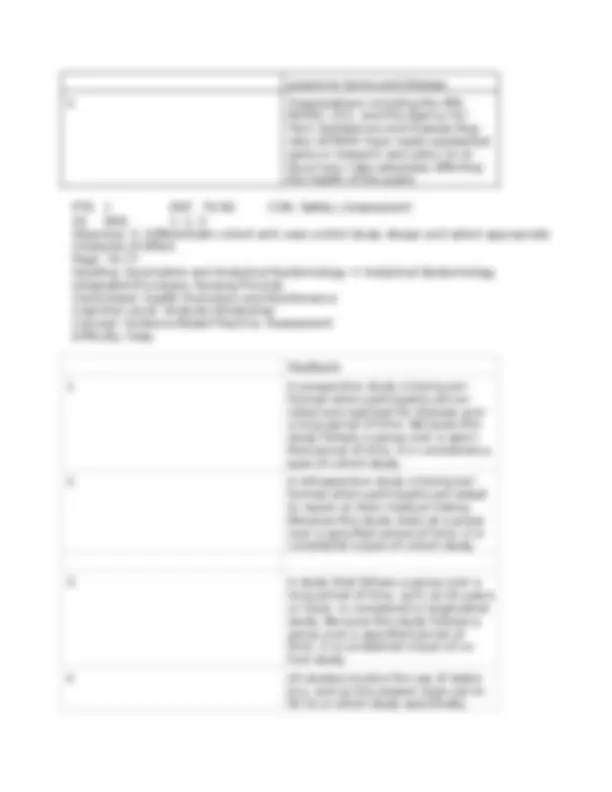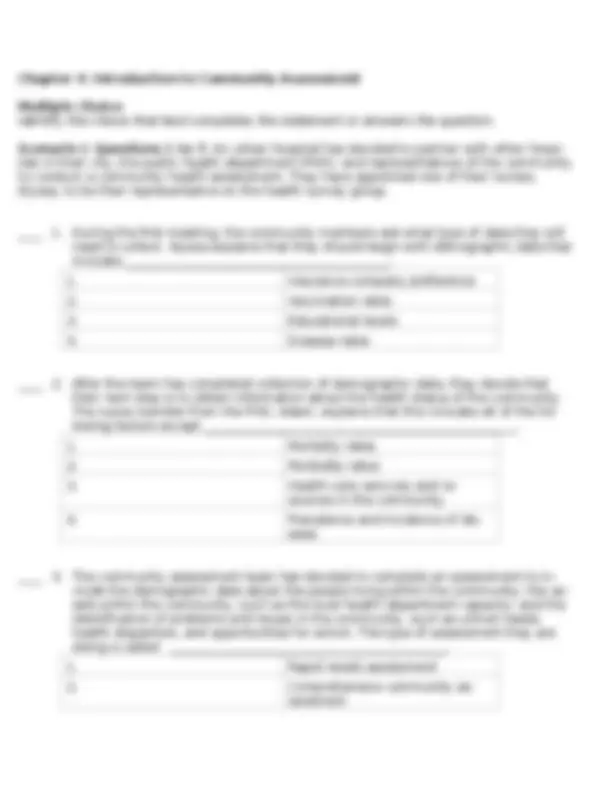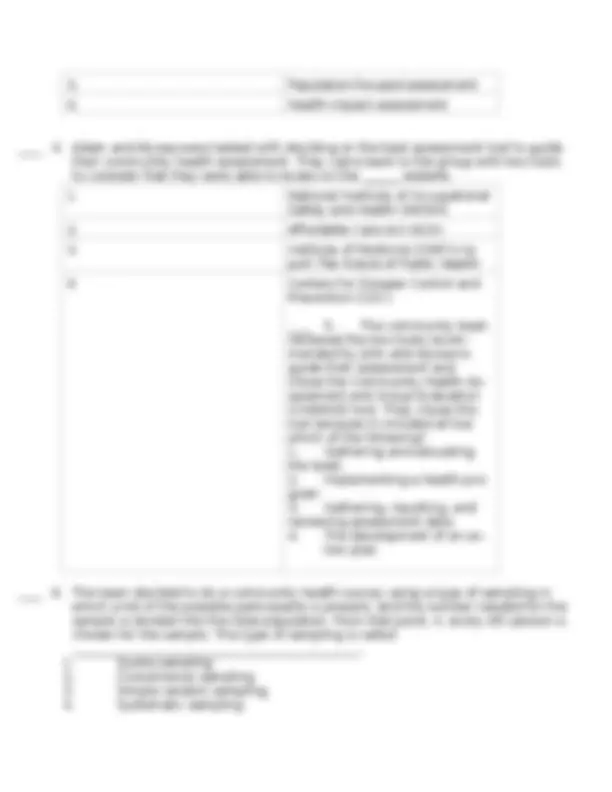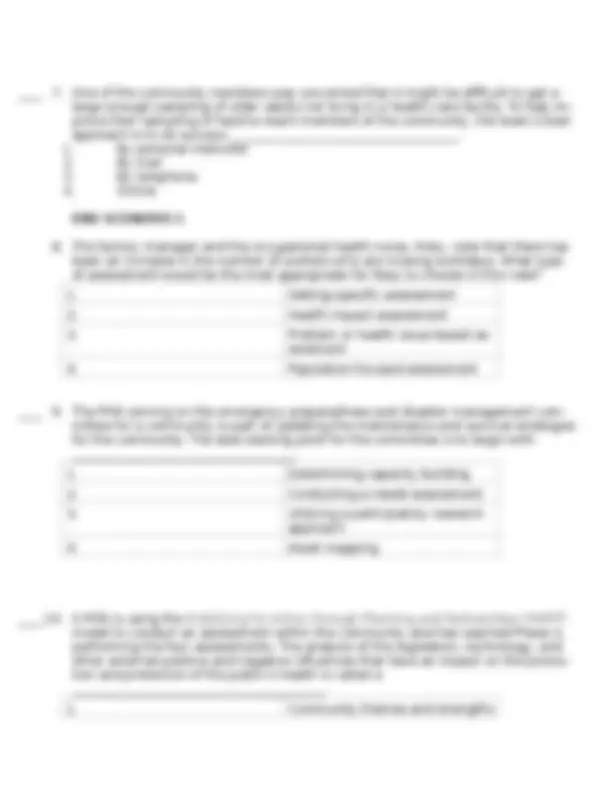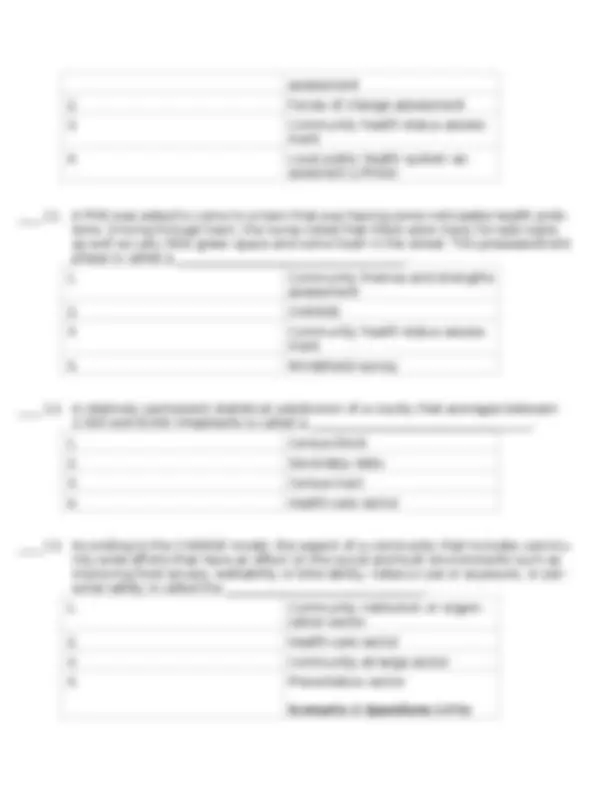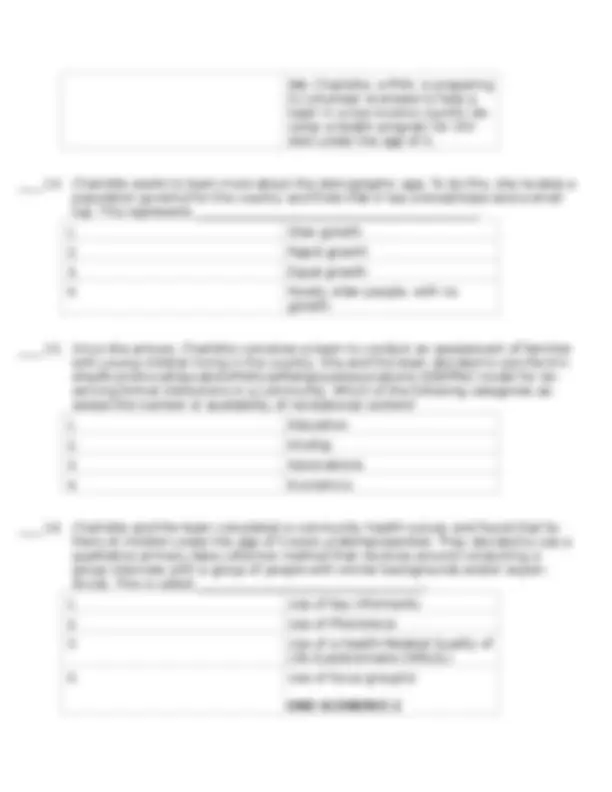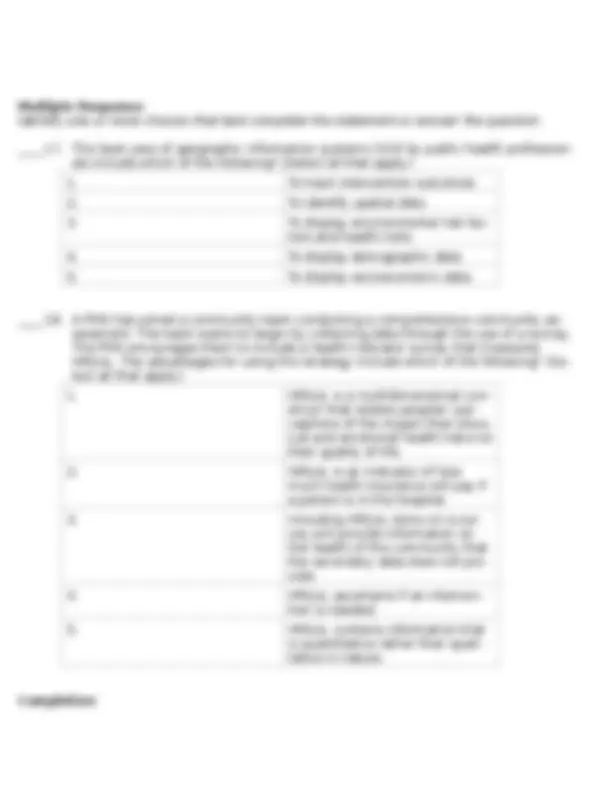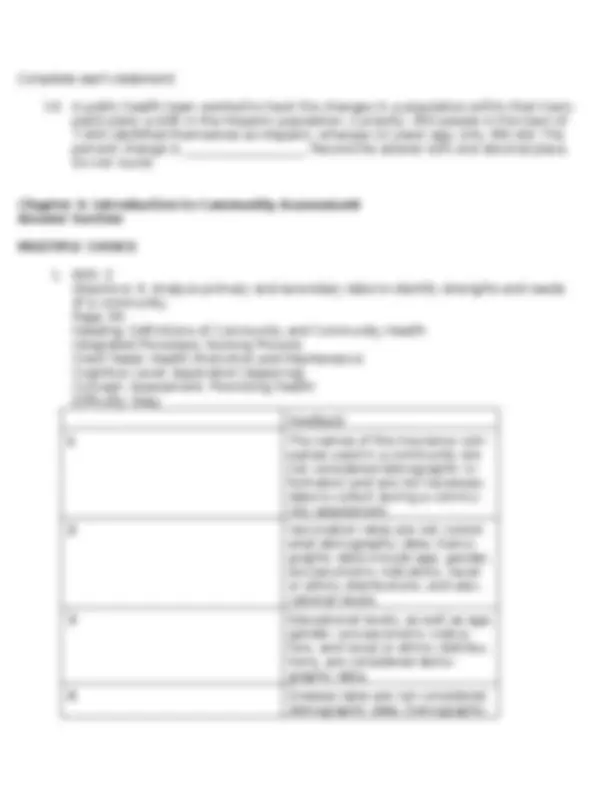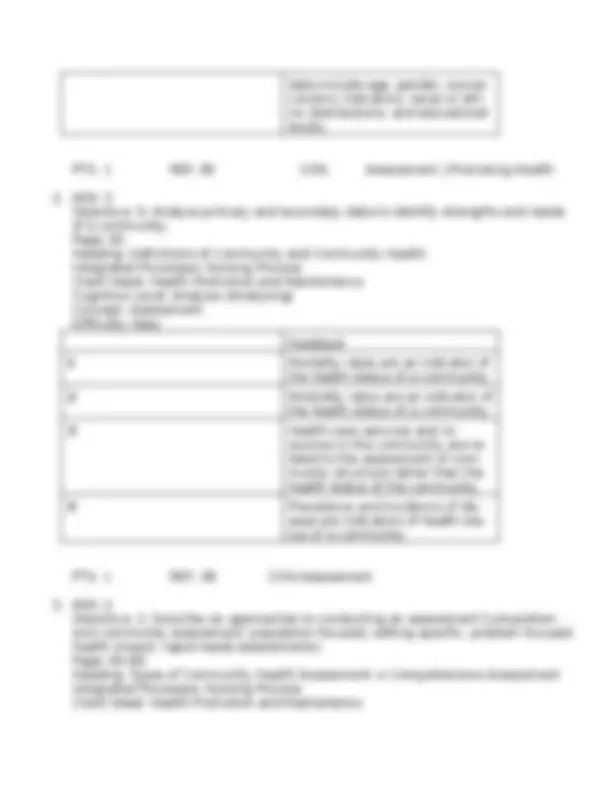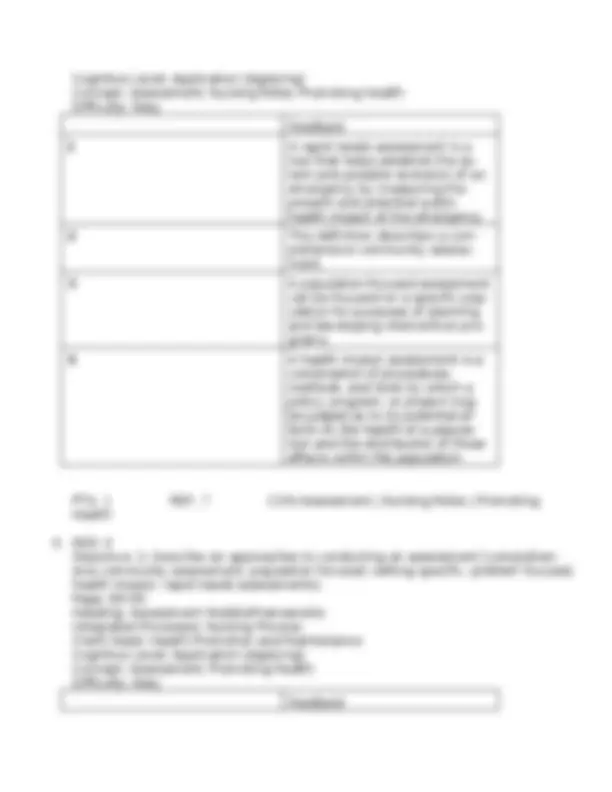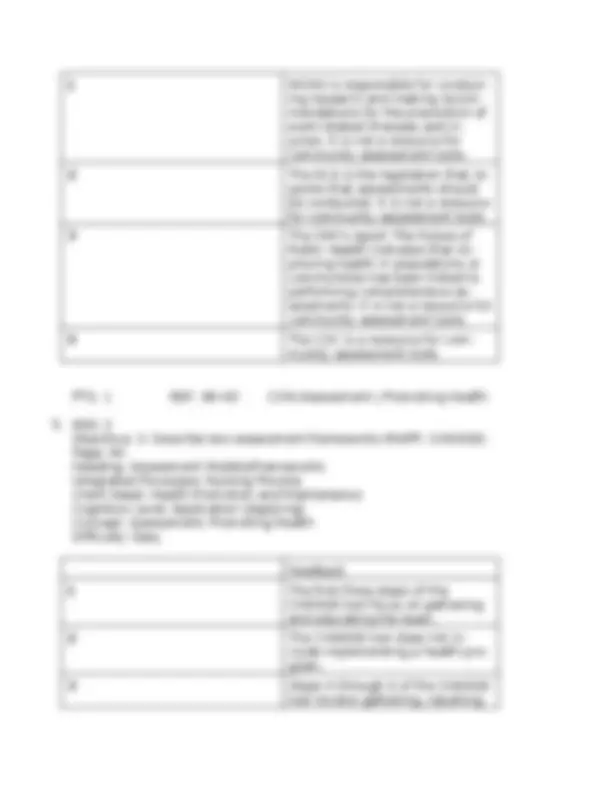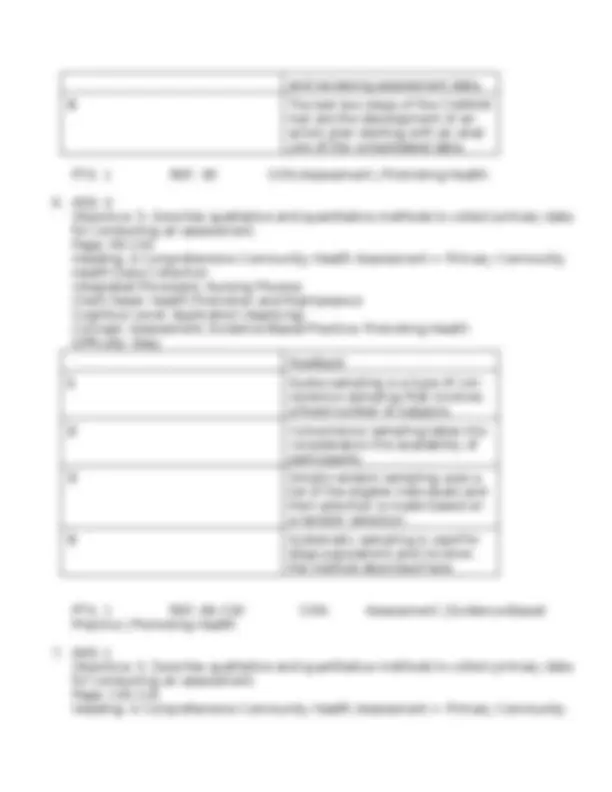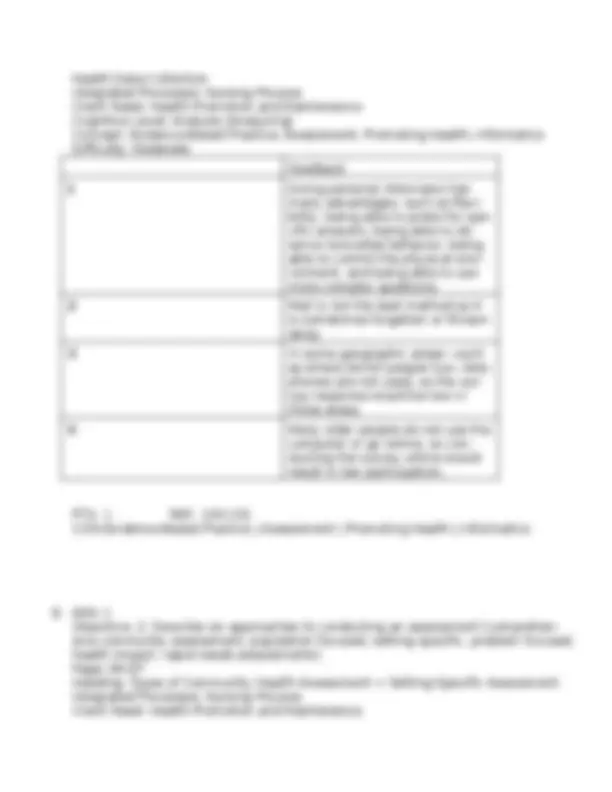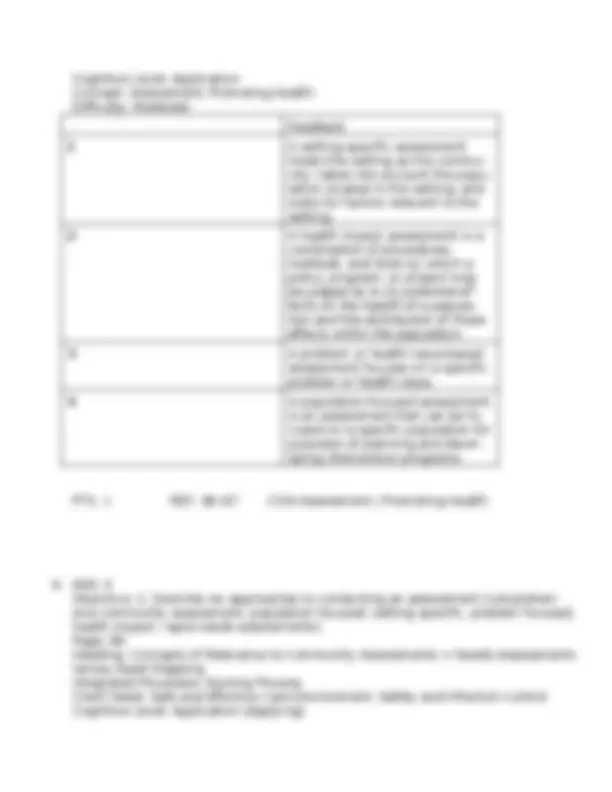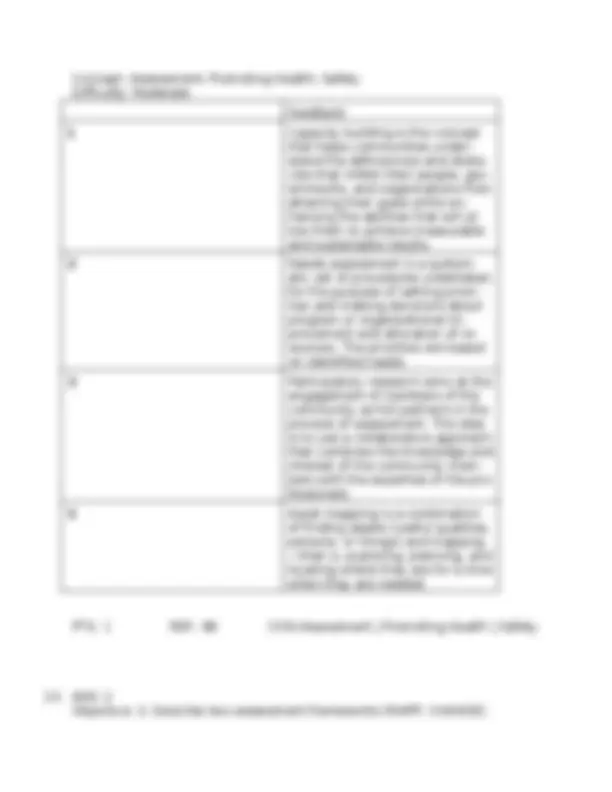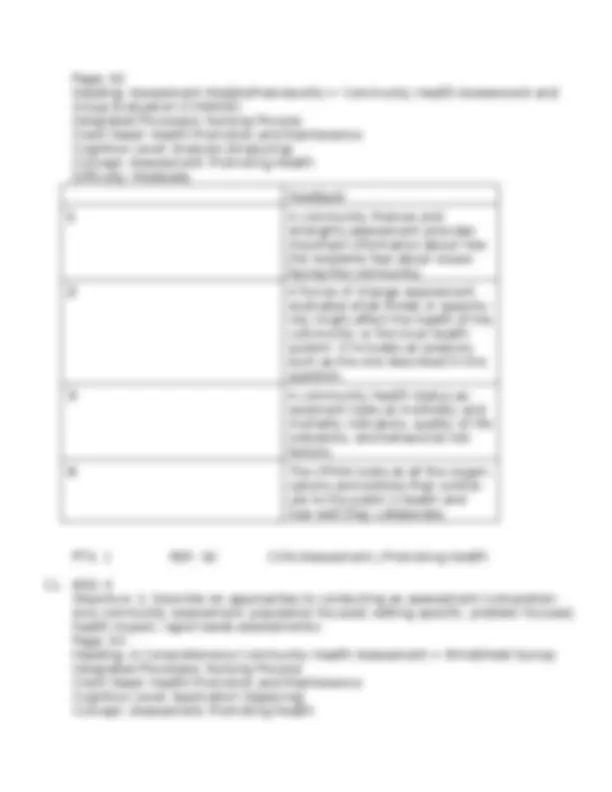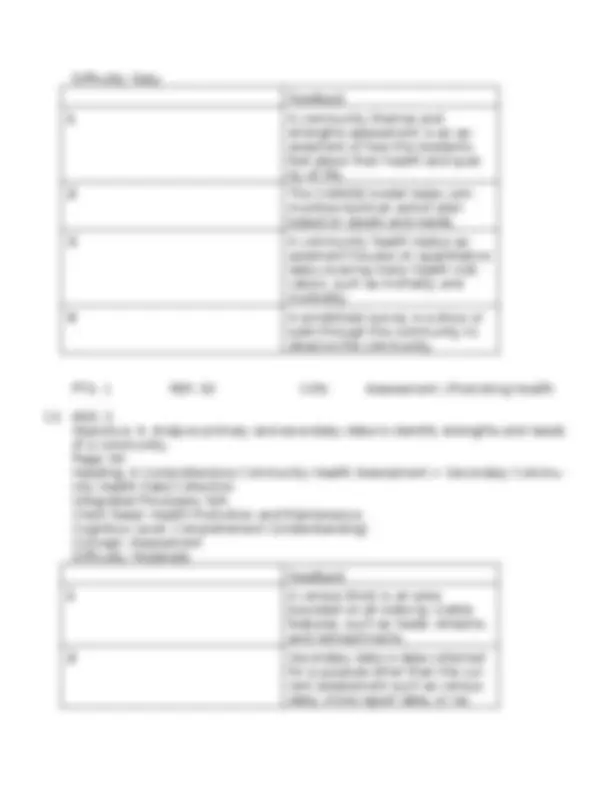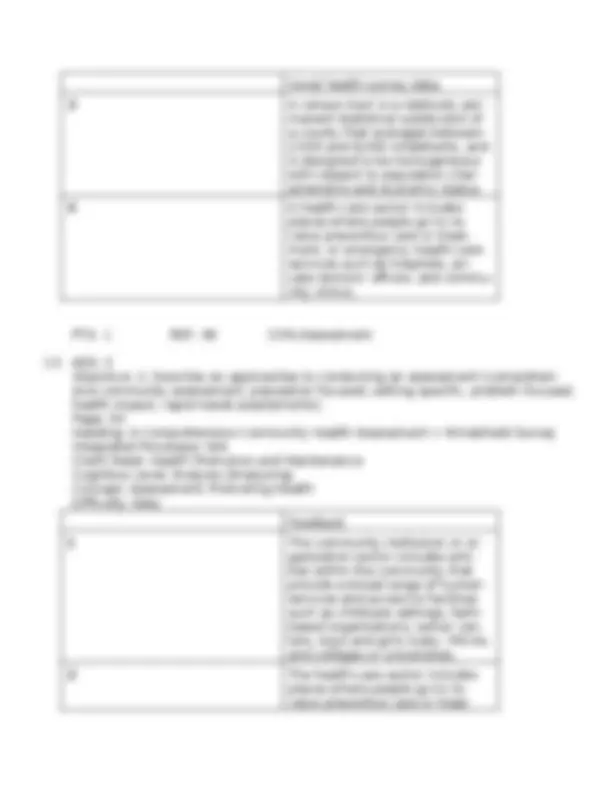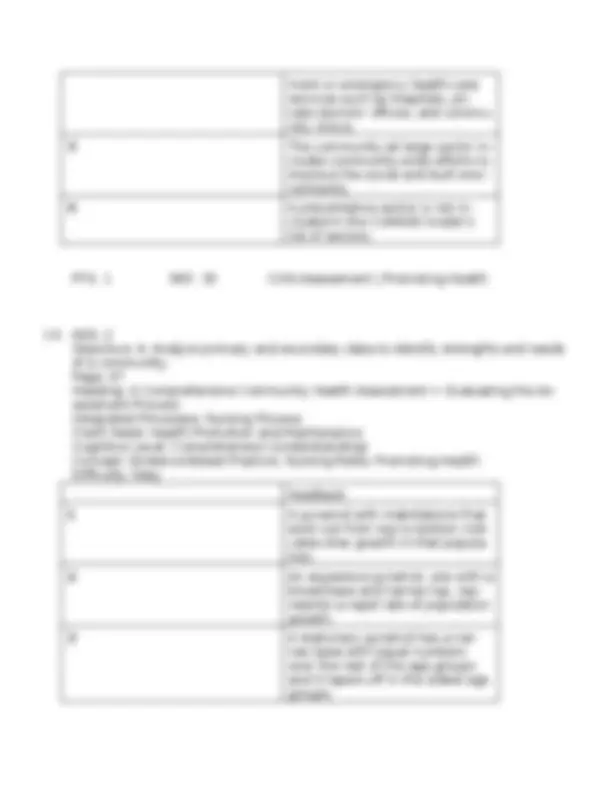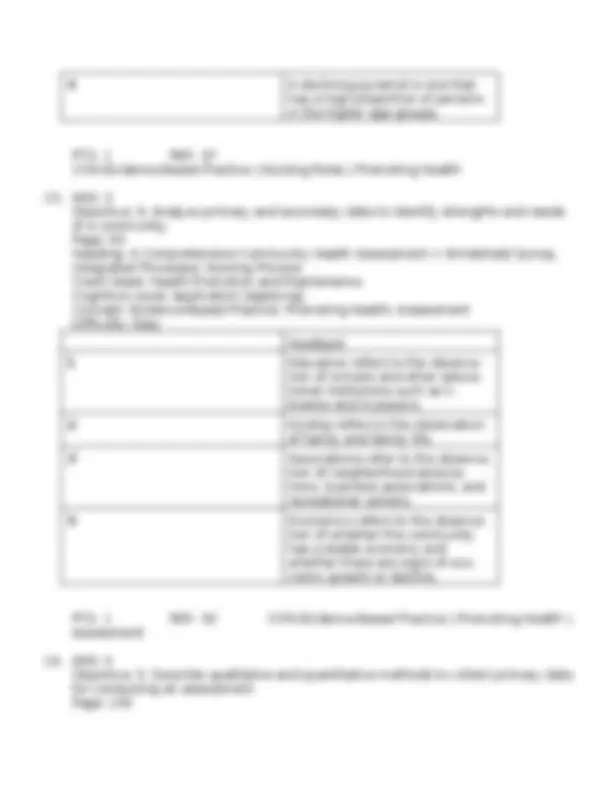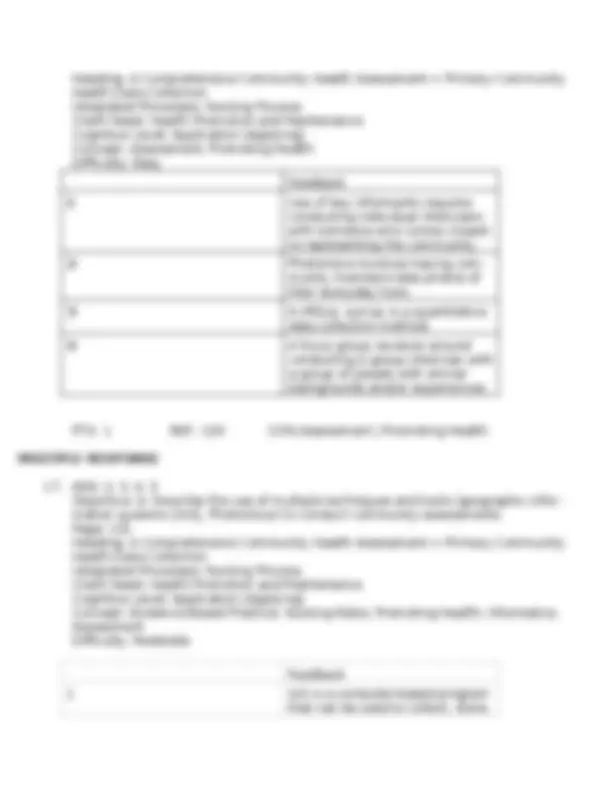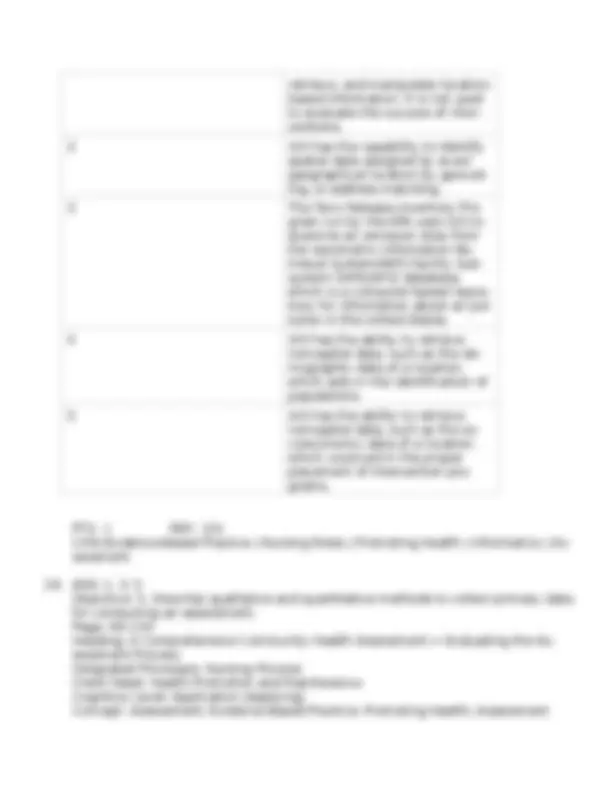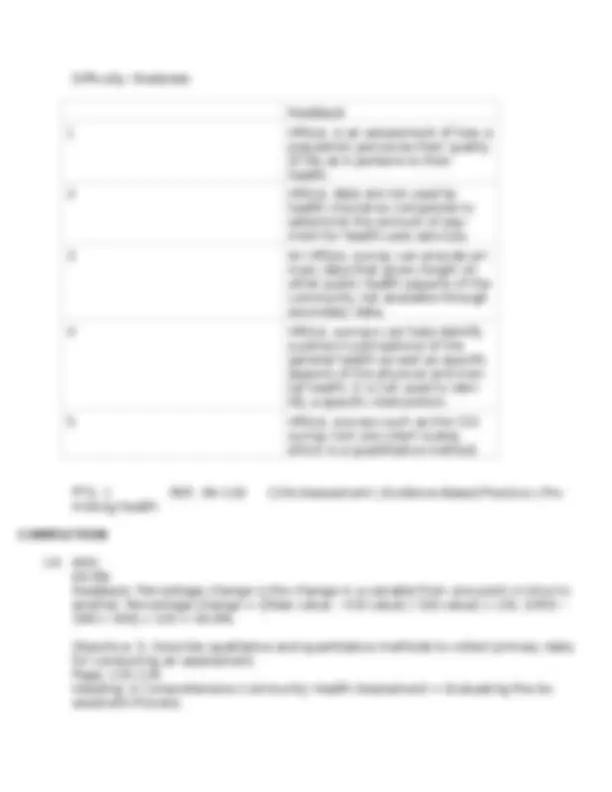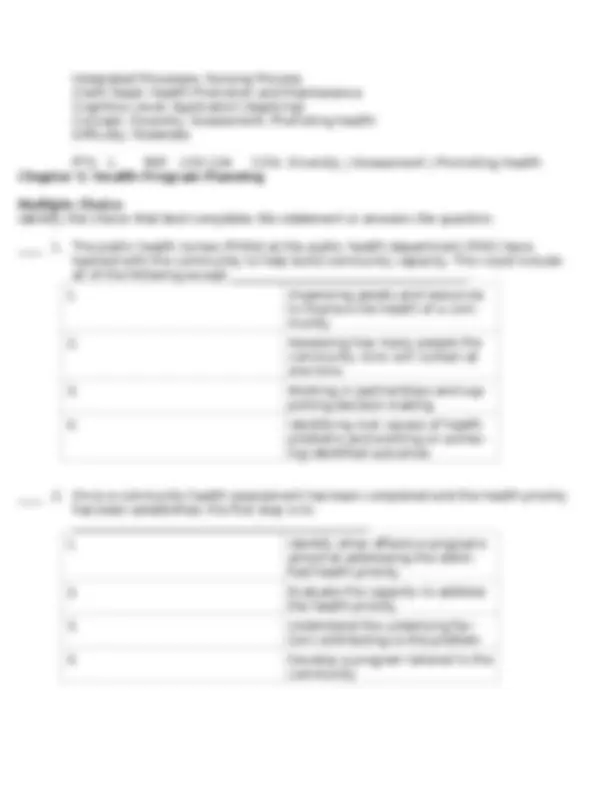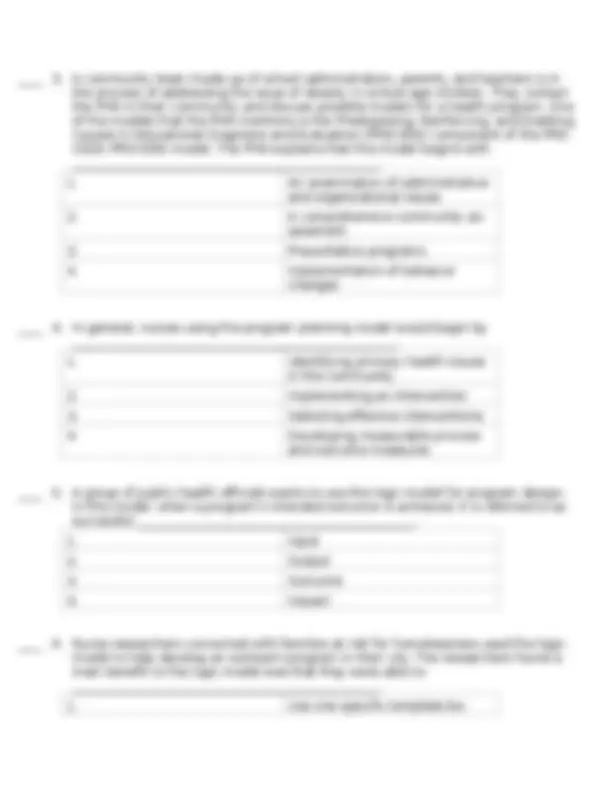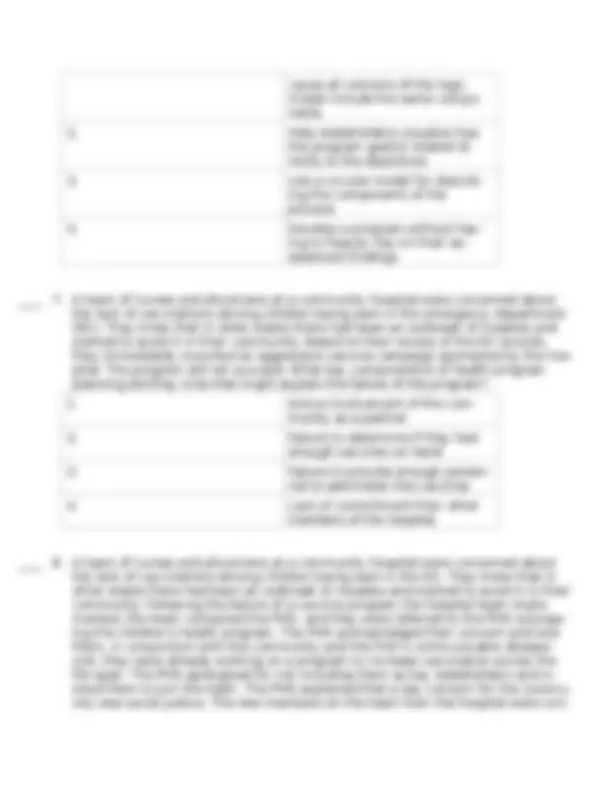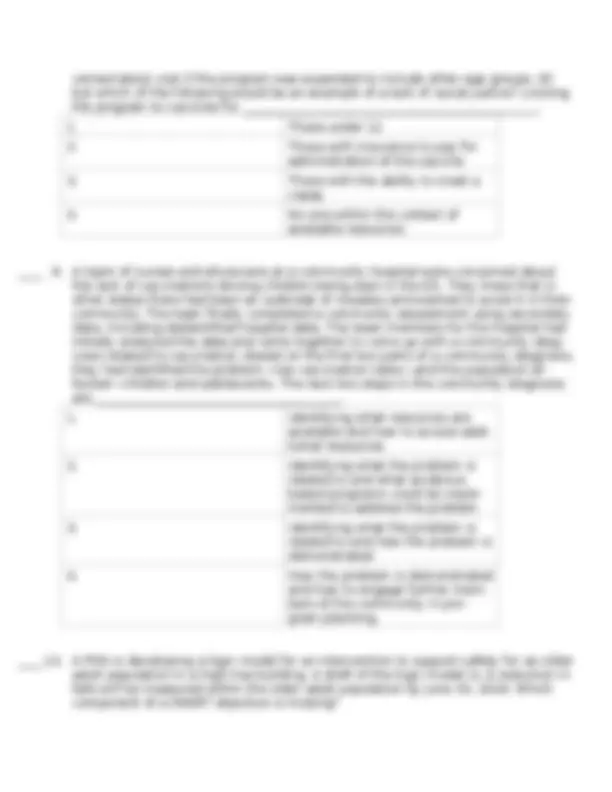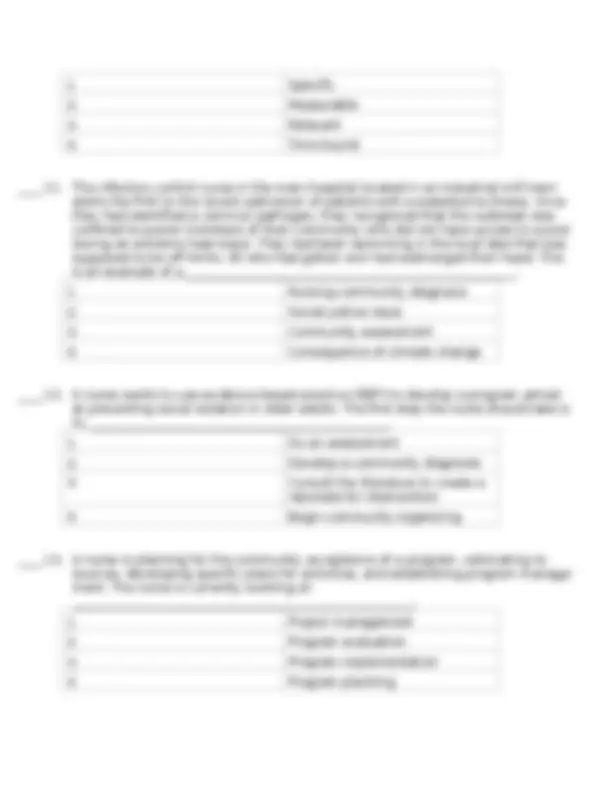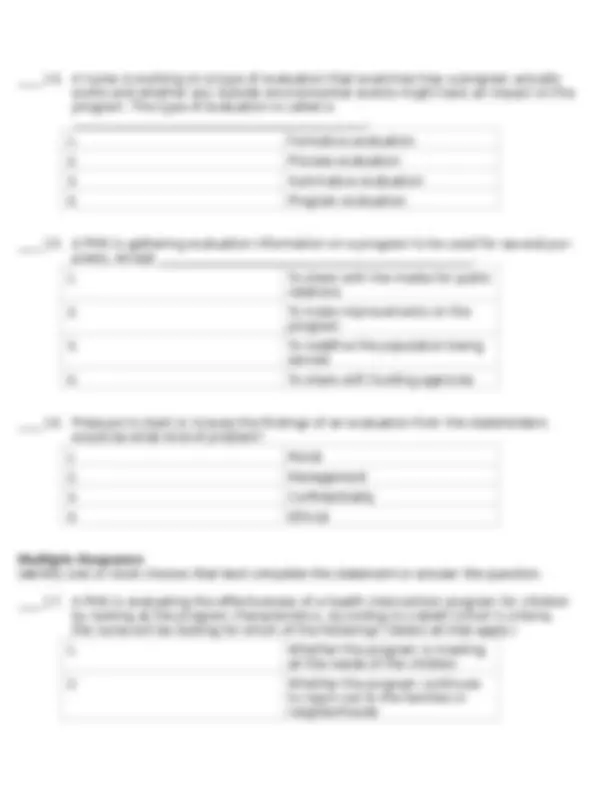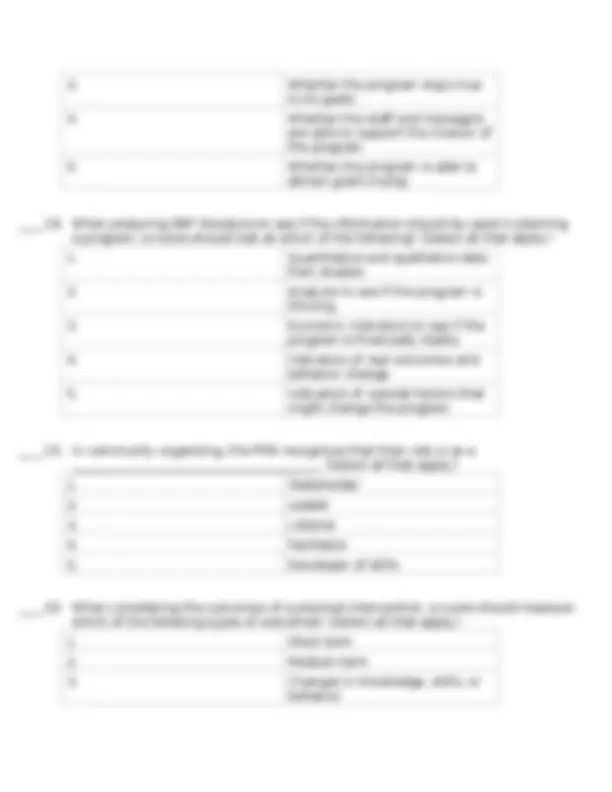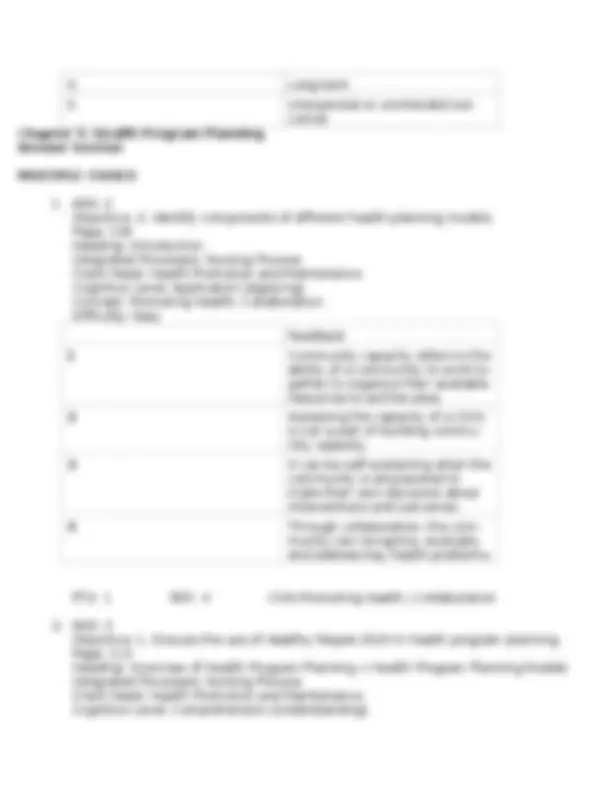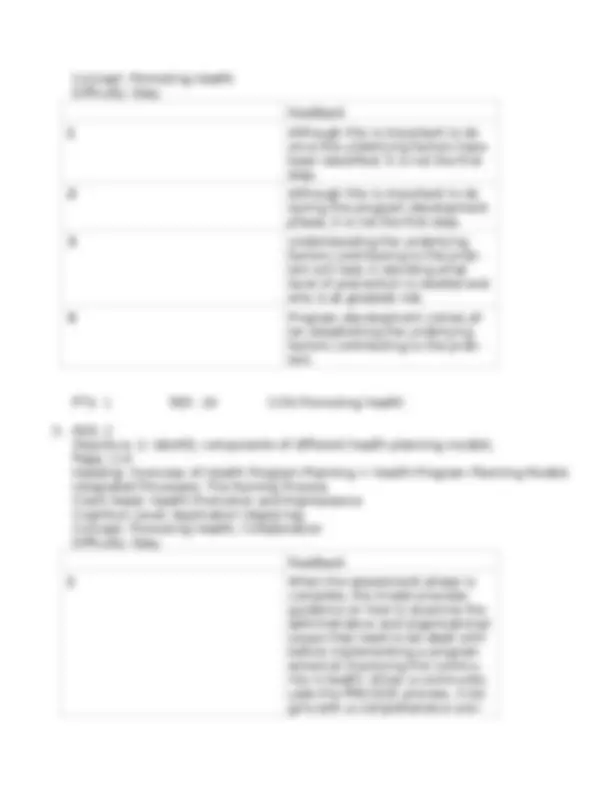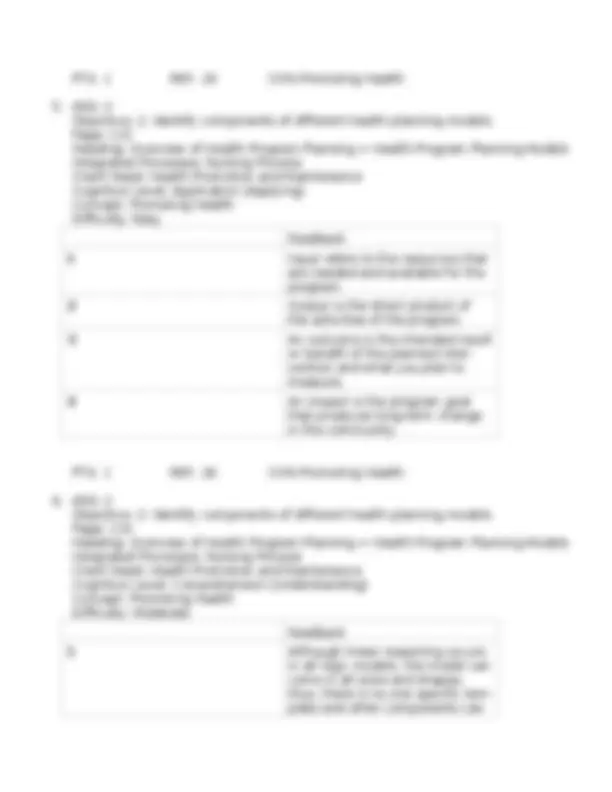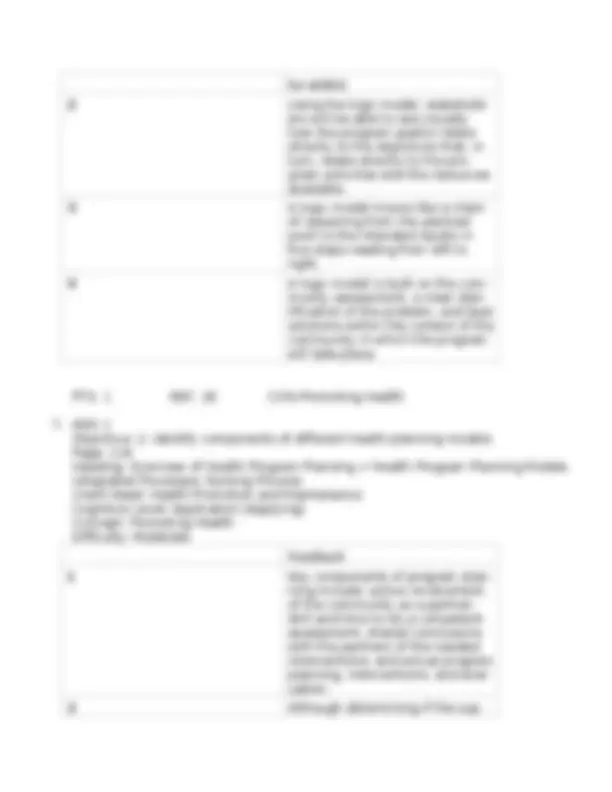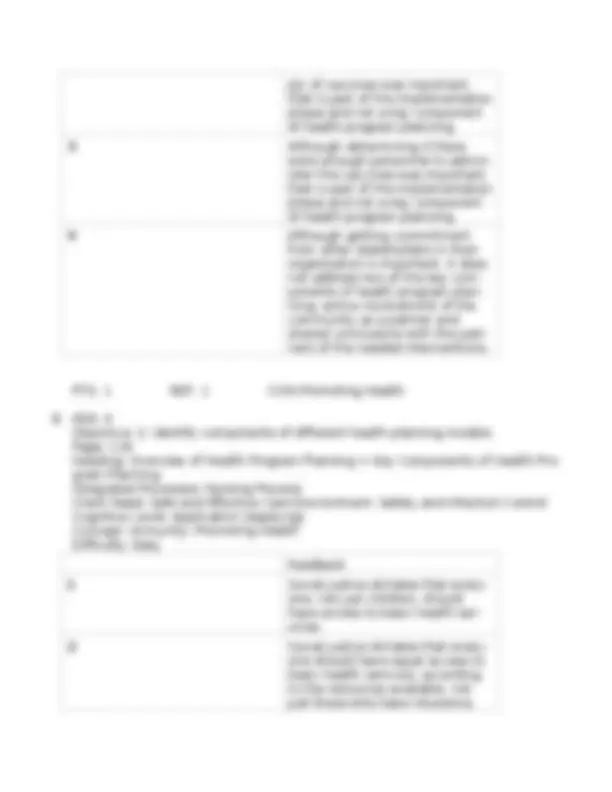Download Community Health Quiz Banks Chapters 1-22 (2025) Actual Exam Questions and Answers A+ Grad and more Exams Community Health in PDF only on Docsity!
Chapter 1: Public Health and Nursing Practice Multiple Choice Identify the choice that best completes the statement or answers the question. ____ 1. Public health nurses (PHNs) rely on public health models to understand population- level health. One model combines an understanding of social conditions and physi- cal conditions to better understand the factors that contribute to health and dis- ease. Which model is this?
- The miasma model
- The germ model
- The epidemiological model
- The ecological model ____ 2. A nursing student is studying public health. She learns that, according to C. E. A. Winslow’s definition, some of the goals of public health include disease prevention, promoting health, control of communicable infections, and __________________.
- Risk assessment for disease
- Promotion of primary care
- Organization of medical and nurs- ing services for the early diagno- sis and preventive treatment of disease
- Governmental safety regulations ____ 3. During the COVID-19 pandemic, the World Health Organization (WHO) had a pivotal role. This organization is _______________________________.
- The public health arm of the United Nations
- Working to improve health and well-being for the global popula- tion
- Working with nurses to promote public health interventions
- All of the above ____ 4. The National Academy of Sciences, Engineering, and Medicine (NASEM) in their re-
port defined the community’s main role in health programs as _______________________________.
- Passive recipient
- Beneficiary
- Collaborators
- Research participants ____ 5. Susan is planning to develop a children’s health initiative in her community. Which of the following are most apt to help improve the community’s acceptance of the program? a. a) Including community members in the planning process b. b) Including the cultural perspectives of each group within the community c. c) Examining the differences between racial groups related to childhood health outcomes d. d) Understanding her own cultural lens
- a, b, d
- a, c, d
- b, c, d
- All of the above ____ 6. A PHN would like to use the Dahlgren-Whitehead model to help herself and other local practitioners understand health in populations. She understands that the Dahlgren-Whitehead ecological model assumes that ___________________________________.
- There are multiple determinants of health, and thus multiple strategies are needed.
- A population and environmental approach is essential.
- Linkages and relationships are crucial.
- All of the above. ____ 7. The PHN completed a community assessment and found that the obesity rate in one of the neighborhoods was higher than in other neighborhoods in the county. She suspects that this is partially because of limited access to full-service grocery stores and a lack of dedicated safe venues for exercise. Assuming her conclusion is
____ 10. Which layer of government was primarily responsible for conducting surveillance during the COVID-19 disease outbreak?
- Federal
- State
- Local
- All of the above ____ 11. As a PHN in a small local public health department, you understand that based on federal mandates your public health department routinely performs all but which of the following?
- Surveillance of disease at the lo- cal level
- Investigation of disease out- breaks
- Licensing of local hospitals
- Quarantine ____ 12. The PHN recognizes that environmental science, epidemiology, biostatistics, bio- medical sciences, and ____ form the foundational subjects of public health.
- Economics
- The humanities
- Social and behavioral sciences
- Anthropology ____ 13. Which of the following emerging threats to population health is not tied directly to globalization?
- Increased travel
- Diffusion of technology
- Greater distribution of tobacco products
- Rising sea levels ____ 14. The first step in the development of cultural humility involves __________________________.
- Developing an understanding of a diverse environment
- Performing a cultural self-assess- ment
- Developing the capacity to pro- vide care in a diverse environ- ment
- Developing knowledge related to the culture of others ____ 15. Diversity refers to all but which of the following concepts?
- Race
- Culture
- Ethnicity
- Environment Multiple Response Identify one or more choices that best complete the statement or answer the question. ____16. The main activities of public health nursing aimed at improving population health in- clude _____________________________. (Select all that apply.)
- Disease surveillance
- Caring for families
- Attending to multiple determi- nants of health
- Emphasizing prevention
- Providing care at community clin- ics ____ 17. Several nurses who work in the emergency department of an urban hospital notice during the evening shift that numerous children in a certain ethnic population have all come in presenting with similar symptoms. The steps the nurses take to address the issue are which of the following? (Select all that apply.)
- Increase antibiotic therapy avail- ability.
- Identify characteristics of the dis-
partnerships, and the concept of population health. Page: 5 Heading: Emerging Public Health Frameworks Integrated Processes: Nursing Process Client Need: N/A Cognitive Level: Knowledge Concept: Critical Thinking Difficulty: Easy Feedback 1 The miasma model precedes our understanding of communicable diseases and pathogens and re- flects a belief that disease was related to an oppressive or un- pleasant atmosphere such as noxious vapors. 2 The germ model emerged with the arrival of microscopes that helped to establish the link be- tween pathogens and disease. 3 The epidemiological model re- flects the role of agent, host, and environment. 4 The ecological model is based on the assumption that health is in- fluenced at several levels: indi- viduals, families, communities, organizations, and social sys- tems. PTS: 1 REF: 5 CON:Promoting Health | Critical Thinking
- ANS: 3 Objective: 2. Describe public health in terms of current frameworks, community partnerships, and the concept of population health. Page: 11 Heading: Public Health Science and Practice Integrated Processes: Nursing Process Client Need: Health Promotion and Maintenance Cognitive Level: Knowledge Concept: Infection; Nursing Roles; Promoting Health Difficulty: Easy
Feedback 1 Risk assessment is considered a part of disease prevention. 2 Promotion of primary care oc- curred through the Alma Ata WHO conference, not Winslow’s defini- tion. 3 Health-care providers are an es- sential component of public health. 4 The goal of public health is to guide governmental policy but not to create regulations. PTS: 1 REF: 11 CON:Infection | Nursing Roles | Promoting Health
- ANS: 4 Objective: 2. Describe public health in terms of current frameworks, community partnerships, and the concept of population health. Page: 3 Heading: Public Health Science and Nursing Practice Integrated Processes: Nursing Process Client Need: Safe and Effective Care Environment: Safety and Infection Control Cognitive Level: Application [Applying] Concept: Promoting Health; Health-Care System; Management; Safety Difficulty: Easy Feedback 1 The WHO is the “directing and co- ordinating authority for health within the United Nations sys- tem.” 2 The WHO has the capability to monitor global epidemiological situations. 3 The WHO brings resources and knowledge to nurses who are working directly with patients for them to make informed decisions. 4 The WHO is the public health arm of the United Nations and works toward both of the previously
1 The correct choice is a, b and d since Including community mem- bers is an essential part of the planning process, various cul- tural/ethnic groups within com- munities may have different cul- tural practices that need to be in- clude. Nurses must have an ap- preciation for cultures repre- sented within the population they care for and Nurses must ac- knowledge and understand their own cultural views of the world, also known as cultural lenses. 2 b is one of three correct choices since Various cultural/ethnic groups within communities may have different cultural practices that need to be included. Nurses must have an appreciation for cultures represented within the population they care for. 3 c is not correct since understand- ing the differences between racial groups in relation to health statis- tics is not directly associated with improving community engage- ment. 4 d is one of the correct choices since Nurses must acknowledge and understand their own cultural views of the world, also known as cultural lenses. PTS: 1 REF: 9 CON:Promoting Health; Community Collaboration
- ANS: 4 Objective: 2 Describe public health in terms of current frameworks, community partnerships, and the concept of population health. Page: 5 Heading: Emerging Public Health Frameworks Integrated Processes: Nursing Process Client Need: Safe and Effective Care Environment: Management of Care
Cognitive Level: Analysis [Analyzing] Concept: Evidence-Based Practice; Promoting Health Difficulty: Moderate Feedback 1 Location and social systems are two of many determinants in the ecology of a public health prob- lem. 2 This model asserts that the envi- ronment of the affected popula- tion is a key component in as- sessing risk factors. 3 Social systems, families, and communities play a role in the health or lack of health for an in- dividual or a population. 4 The Dahlgren-Whitehead model is key to understanding the layers of influence and relationships re- garding population health and how important environment is to said health. Thus, all of the an- swer choices together are cor- rect. PTS: 1 REF: 5 CON:Evidence-Based Practice | Promoting Health
- ANS: 1 Objective: 4. Explore the connection between environment, resource availability, and health. Page: 5 Heading: Emerging Public Health Frameworks Integrated Processes: Nursing Process Client Need: Health Promotion and Maintenance Cognitive Level: Analysis Concept: Promoting Health; Economics Difficulty: Moderate Feedback 1 Upstream refers to determinants of health that include the physical environment as well as conditions in the social environment creat-
the increase in the disease rate. PTS: 1 REF: 6 CON:Nursing Roles | Communication | Collabora- tion
- ANS: 2 Objective: 2. Describe public health in terms of current frameworks, community partnerships, and the concept of population health. Page: 6 Heading: Community Partnerships Integrated Processes: Nursing Process Client Need: Communication and Documentation Cognitive Level: Application [Ap- plying] Concept: Promoting Health; Collaboration Difficulty: Easy Feedback 1 This collaboration benefits the community’s public health after a natural disaster. 2 Community collaboration can in- clude advocating for change in regulations but does not involve direct legislative activity that is the responsibility of governmen- tal bodies. 3 A volunteer group can offer valu- able services to enhance the lives of people suffering from mental illness. 4 This community-based institution is an example of a social system that can work with a health de- partment to use each other’s strengths to produce a meaning- ful project. PTS: 1 REF: 6 CON:Promoting Health | Collaboration
- ANS: 3 Objective: 6. Identify the formal organization of public health services from a global to local level.
Page: 19 Heading: Local Public Health Departments Integrated Processes: Clinical Judgment Client Need: Safe and Effective Care Environment: Safety and Infection Control Cognitive Level: Comprehension Concept: Health-Care System; Regulation; Infection Difficulty: Easy Feedback 1 The Constitution did not provide for a national public health agency but rather assigned that duty to the states. Although the Centers for Disease Control and Prevention (CDC) provides ongo- ing research, sets guidelines, and offers support, quarantines are usually the responsibility of local health departments. 2 State constitutions empower the states to establish state boards of health. Their duty is to protect the citizens, but quarantines are mostly managed at the local level. 3 Quarantines are managed at the local level with assistance from the state if needed. 4 Not all levels of government are needed or agile enough to handle local health crises. PTS: 1 REF: 19 CON:Health-Care System | Regulations | Infection
- ANS: 3 Objective: 6. Identify the formal organization of public health services from a global to local level. Page: 19 Heading: Local Public Health Departments Integrated Processes: N/A Client Need: Safe and Effective Care Environment: Safety and Infection Control Cognitive Level: Application [Applying] Concept: Health-Care System; Regulations
useful tool to assess the impact of a health program, it is not con- sidered one of the foundational subjects of public health. 2 The humanities are not consid- ered one of the foundational sub- jects of public health. 3 Many branches of social and be- havioral sciences are useful for analysis of public health issues. 4 The study of man and his devel- opment is not considered one of the foundational subjects of pub- lic health. PTS: 1 REF: 3 CON:Evidence-Based Practice | Promoting Health
- ANS: 4 Objective: 4. Explore the connection between environment, resource availability, and health. Page: 4 Heading: Public Health Frameworks: Challenges and Trends Integrated Processes: N/A Client Need: N/A Cognitive Level: Knowledge Concept: Environment; Economics Difficulty: Easy Feedback 1 Increased travel is a result of globalization and has increased the transmission of disease. 2 Diffusion of technology can result in increased disparity between high-income and low-income countries. 3 Because of increased trade across borders, tobacco products are more readily available glob- ally. 4 Rising sea levels are related to climate change and not directly
associated with globalization. PTS: 1 REF: 4 CON:Promoting Health
- ANS: 2 Objective: 3. Define the constructs of culture, diversity, and social determinants of health. Page: 9 Heading: Cultural Competency and Cultural Humility Integrated Processes: Nursing Process Client Need: Safe and Effective Care Environment Cognitive Level: Application [Applying] Concept: Promoting Health; Cultural Competency; Cultural Humility Difficulty: Moderate Feedback 1 Developing an understanding of a diverse environment is related to cultural competence. 2 The first step in this process for individual nurses should be a cul- tural self-assessment. Cultural self-assessment involves a critical reflection of one’s own view- points, experiences, attitudes, values, and beliefs. 3 Developing the capacity to pro- vide care in a diverse environ- ment is related to cultural compe- tence. 4 Developing knowledge related to the culture of others, though an important step, involves acquir- ing knowledge, not self-assess- ment of one’s own cultural lens. PTS: 1 REF: 9 CON:Cultural Competency/Humility
- ANS: 4 Objective: 3. Define the constructs of culture, diversity, and social determinants of health. Page: 7– Heading: Cultural Context and Nursing Care
sponsibilities of public health or- ganizations. 2 Though PHNs provide care to families, it is not the main focus of PHN practice but rather an ex- ample of how to improve popula- tion health. 3 Public health nursing focuses on improving population health by emphasizing prevention and at- tending to multiple determinants of health. 4 Public health nursing focuses on improving population health by emphasizing prevention and at- tending to multiple determinants of health. 5 Though PHNs often provide care at community clinics, it is not the main focus of public health nurs- ing practice. PTS: 1 REF: 12 CON:Public Health Nursing Practice
- ANS: 2, 3, 4, 5 Objective: 4. Explore the connections between environment, resource availability, and health. Page: 7 Heading: Population Health and Population-Focused Care Integrated Processes: Nursing Process Client Need: Physiological Integrity Cognitive Level: Synthesis Concept: Assessment; Critical Thinking Difficulty: Moderate Feedback 1 Antibiotics may not be a neces- sary route of treatment for the di- agnosis. 2 The first step is to note and com- pare symptoms, onset, and other information to ascertain whether
this is the same illness and if it is potentially because of a common cause. 3 Grouping the patients according to diagnosis will allow the health- care team to give better care and help create a care map, but it would not be the first step. 4 Once the data on symptoms, on- set, and other key information has been gathered, the next step is to inform the public health de- partment if warranted. 5 Evaluating the environment of the patients may create an un- derstanding of why the illness oc- curred and prevent a reoccur- rence of the illness; this would oc- cur as part of the public health department’s outbreak investiga- tion, if one is warranted. PTS: 1 REF: 7 CON:Infection | Assessment
- ANS: 1, 2, 3, 4 Objective: 5. Identify the key roles and responsibilities of public health nurses (PHNs). Page: 12 Heading: Public Health Nursing as a Specialty > Public Health Nursing Scope and Standards of Practice Integrated Processes: N/A Client Need: N/A Cognitive Level: Knowledge Concept: Regulations; Nursing Roles Difficulty: Easy Feedback 1 The PHN collects comprehensive data pertinent to the health sta- tus of populations. 2 The PHN analyzes the assess- ment data to determine the diag-

